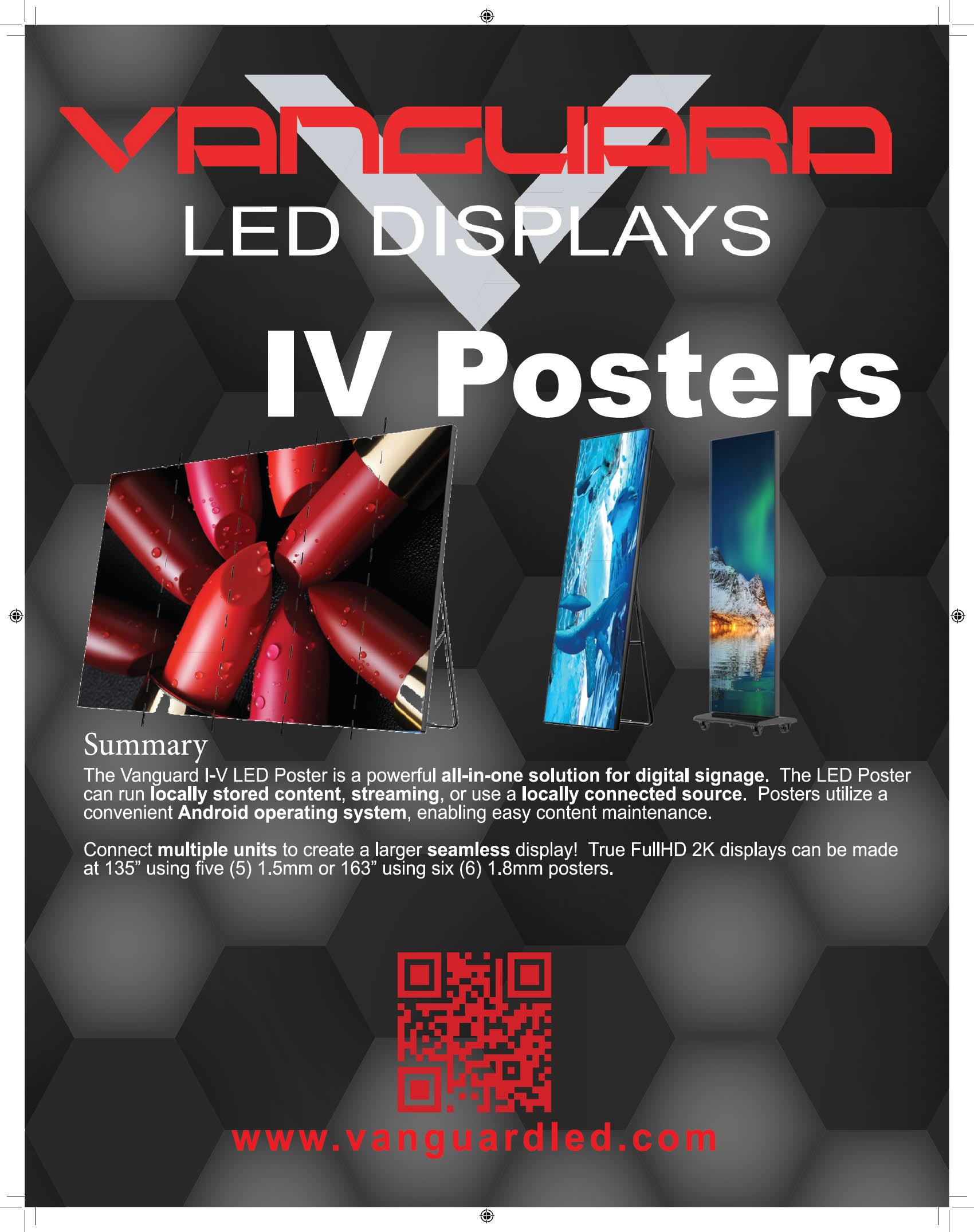
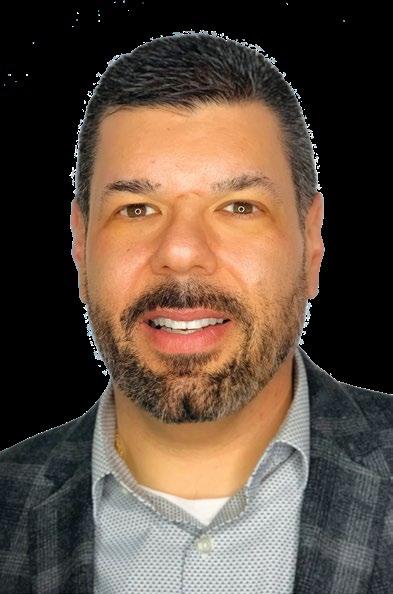
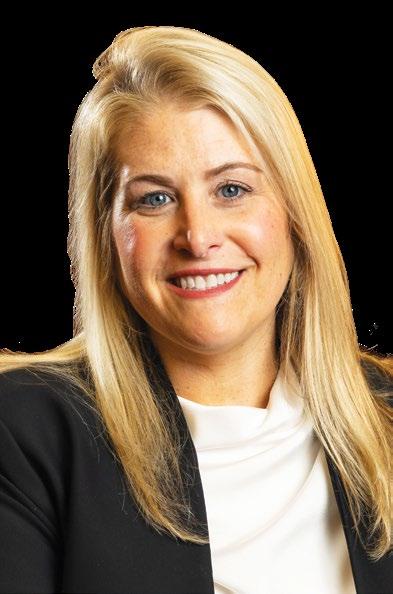

















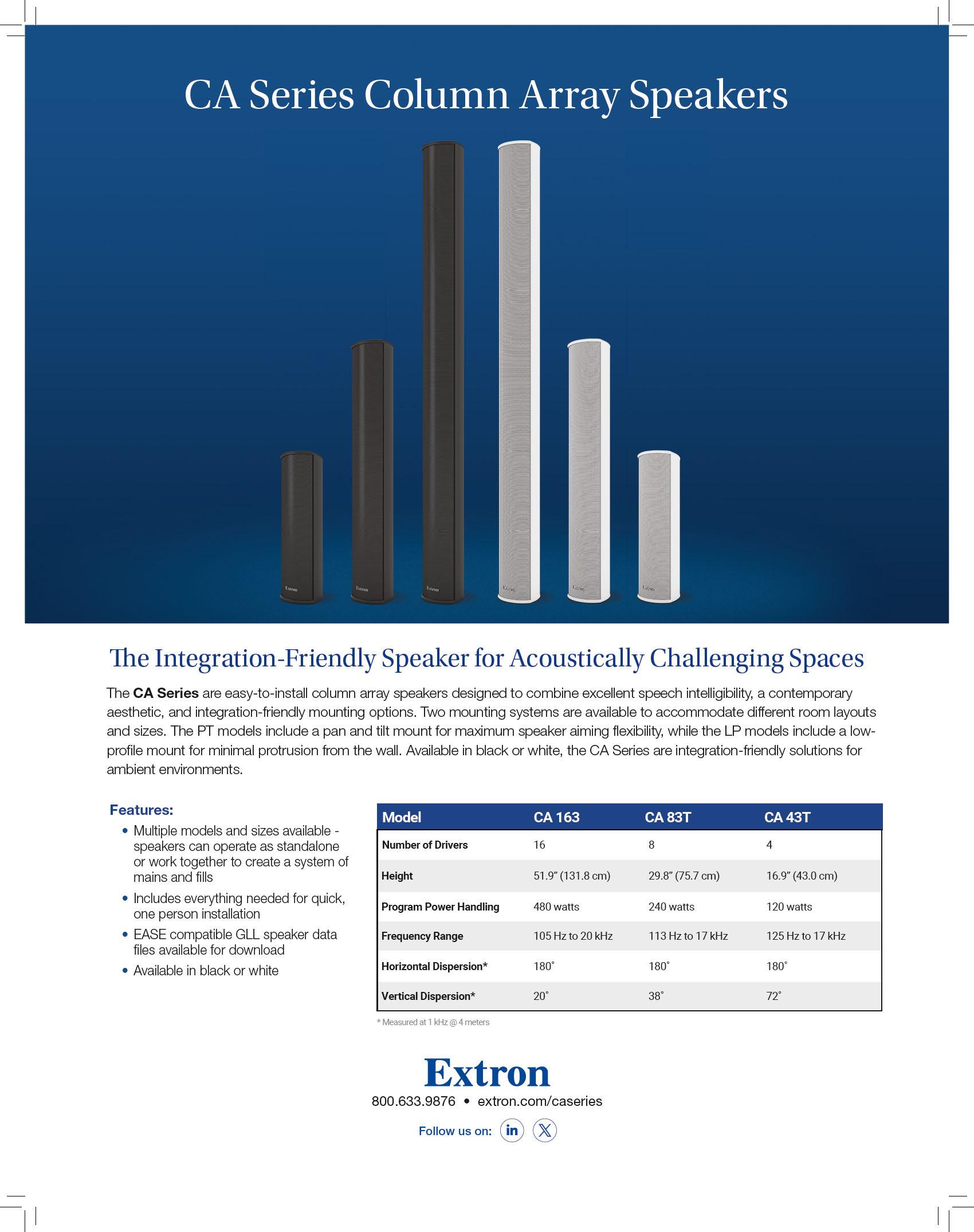




















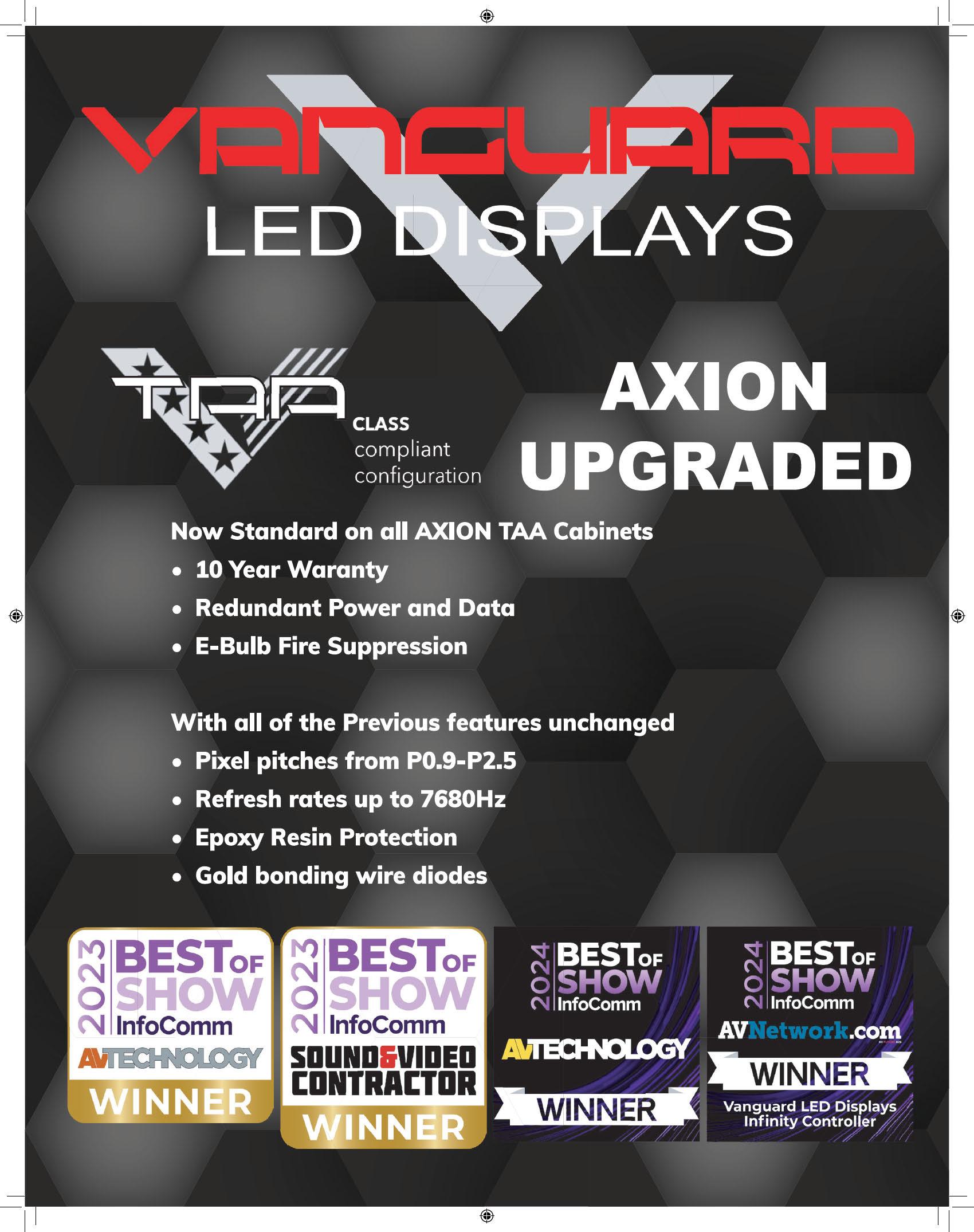













































Whether it’s fine dining or a sports bar, Pro AV solutions are making sure patrons come back for seconds. By James Careless
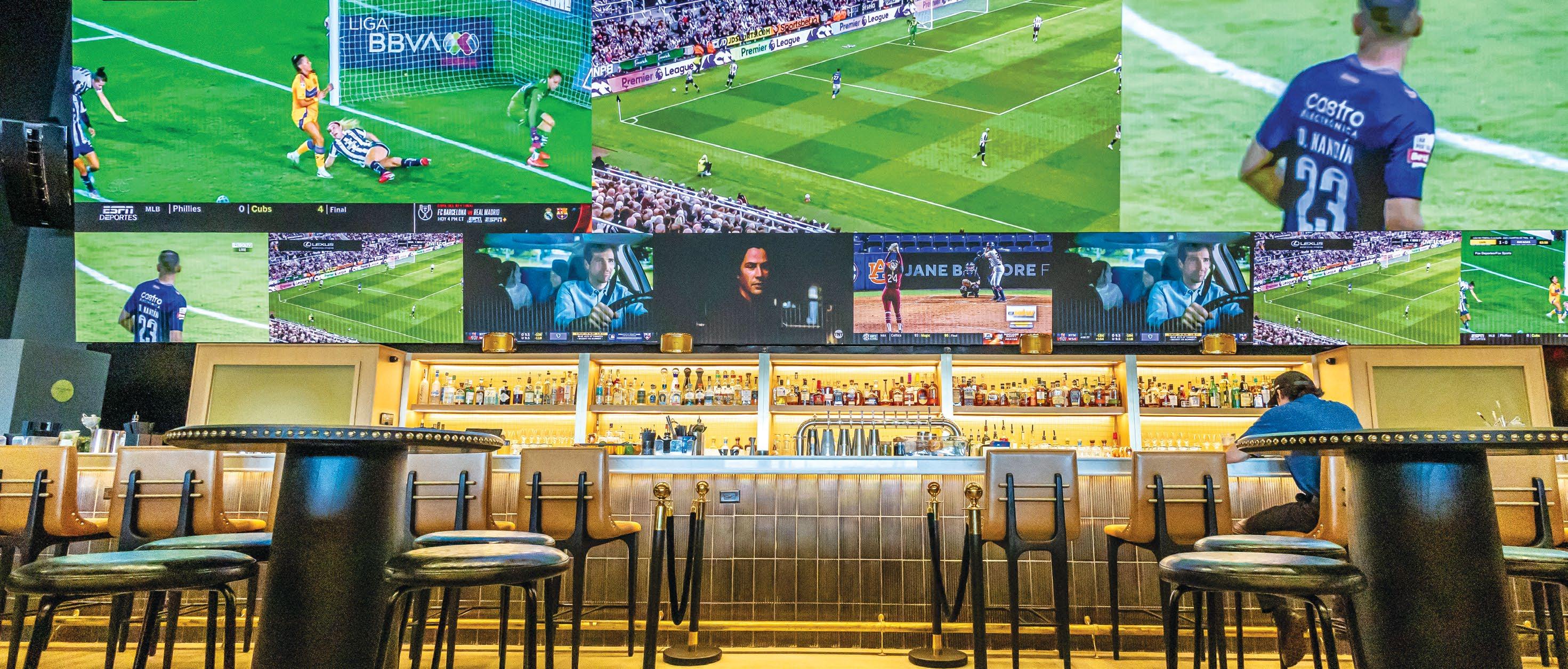
18 Executive Q&A
MSolutions CEO Eliran Toren talks HDBaseT, USB-C, and KVM choices.
By Mark J. Pescatore
23 On Your Business
Learn how to persevere when your business faces leaner times.
By Steve Greenblatt

24 It's Time for InfoComm 2025
Jenn Heinold, AVIXA’s new SVP of expositions, Americas, expects plenty of convergence and AI talk at InfoComm 2025.
By Mark J. Pescatore

26 InfoComm 2025: AI, Tariffs, and Immersive Innovation
Get insights about the upcoming InfoComm 2025 event from some of the exhibitors. By Wayne
Cavadi
30 Historic Style, Modern Tech
The new Maury County Judicial Center remembers history while relying on modern courtroom AV technologies.
By Carolyn Heinze
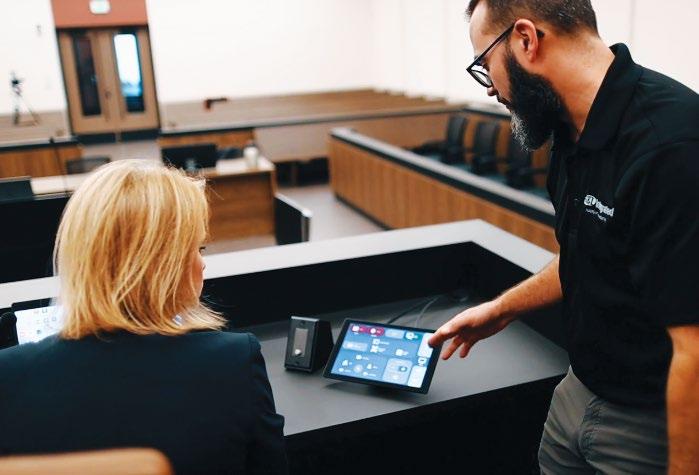
32 All the School Is a Stage Pliant Technologies ensures clear communications across the campus of Plainfield High School.
By Wayne Cavadi
34 Over the ‘Rainbow Effect’
RGB laser technology is eliminating color separation artifacts from earlier DLP projectors.
By George Walter
36 Review: Two-for-One Recording
Shure’s new MV7i microphone lets you plug in a second source—no mixer needed—but how does it work?
By Mark J. Pescatore
37 Review: Think Outside the ‘Box’
The new Studio 4K from PTZOptics is changing the fixed camera conversation.
By Chuck Gloman
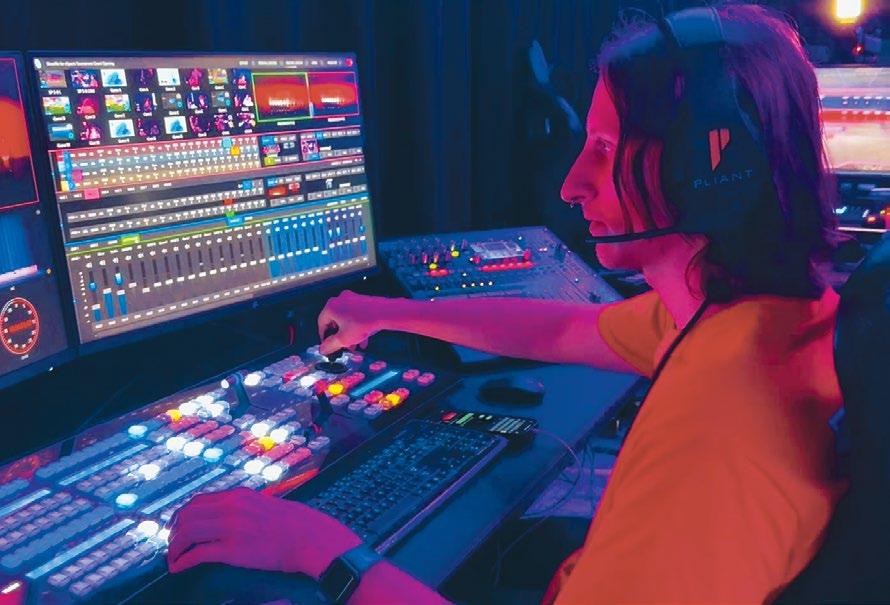
41 AVoIP and KVM in the Control Room Today’s advanced solutions could reduce clutter and improve performance.
By David Isola Departments
SYSTEMS CHECK
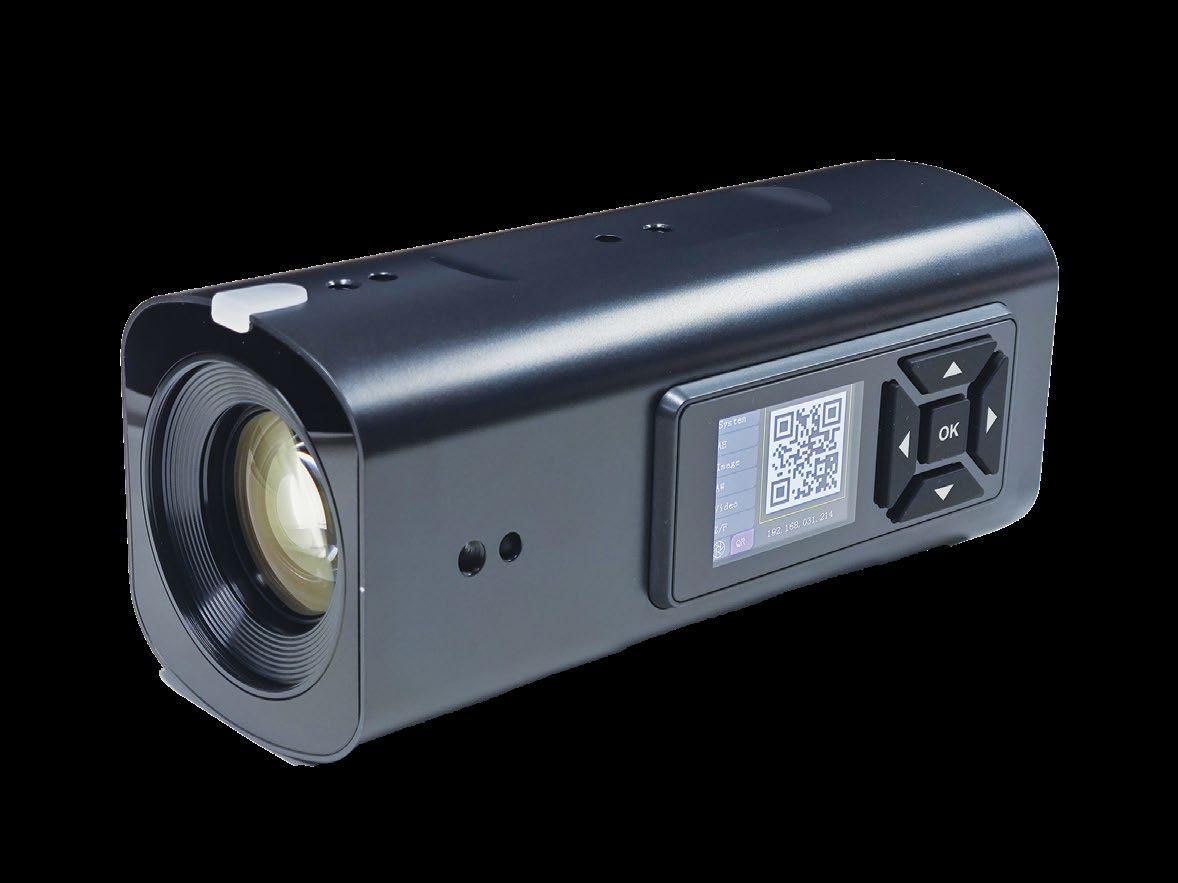
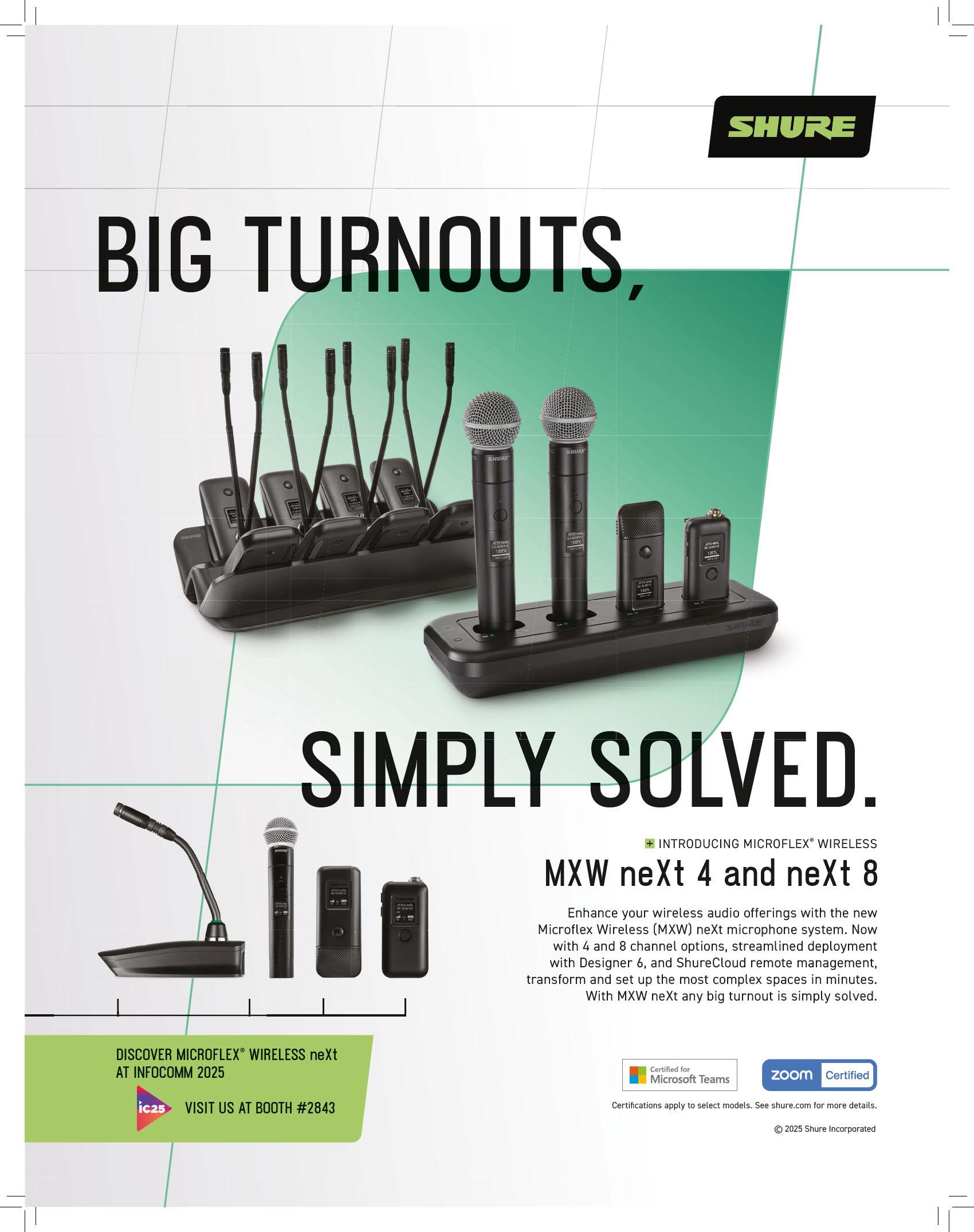

In the summer of 2014, social media helped power the success of the ALS Ice Bucket Challenge. People would dump cold water on their heads and challenge their friends to do the same. According to the ALS Association, the trend helped raise awareness for amyotrophic lateral sclerosis (also known as Lou Gehrig’s disease) as well as more than $115 million for medical research, care, and advocacy.
Recently, my teenager asked me to dump a bucket of cold water on her head while my wife shot a video of the activity. Turns out there’s a new USC Speak Your MIND Ice Bucket Challenge, which was launched in early spring by the Mental Illness Needs Discussion (MIND) club at the University of South Carolina. The goal is to spread awareness of mental health and collect donations for Active Minds, a nonprofit organization with a mission to transform mental health norms.

Also in early spring, another viral trend invaded social media platforms. That’s because on March 25, OpenAI launched an advanced image generator for its GPT-4o model for ChatGPT—and made it free to use. Suddenly, feeds were filled with custom AI action figures of various quality.
Since last year’s attempt to update my headshot via AI went amiss, I figured I’d try to repair my relationship with AI with a less serious exercise. Now, GenAI tools like ChatGPT operate based on the prompts (input) you provide. Provide a short burst of inspiration (“use this photo to make a posable action figure”) and you’re likely to be uninspired by the results. The more detailed and specific the prompts, the better the finished product.

My first attempt was created using Bylo.ai and my current headshot. The site was kind enough to provide a pretty detailed prompt to simplify the process. I added some specifics, including what accessories should be included in my blister pack, and pressed the magic button.

I did not insist on a photorealistic action figure. That’s really the only way I can explain the action figure that the AI provided (far left). In real life, I’m the height of the average American male. My action figure is noticeably shorter. And stockier. Look, I know I need to lose a few pounds, but action figure Mark needs to actively research the keto diet. I’m not saying it looks like a hobbit in a blazer, but I’m not saying it doesn’t, either. And don’t get me started on the “reporler’s notebook.”
When I tried ChatGPT, I used a different headshot from the 2025 NAB Show (thanks to the Leadership Foundation and FUJIFILM), as well as a different prompt based on suggestions I found on the internet. What you’re seeing is the fourth attempt; I continued to add details to refine my action figure.
He’s also height challenged, even though my prompt included the term “average height and build,” so apparently ChatGPT needs more guidance with personal dimensions. The microphone and laptop went through changes in every version, and I have no idea why it decided to change my notebook into a “notebock” (it was correct in previous versions). While the packaging looks ready for an endcap display, the overall final result looks less like an action figure and more like a picture of an action figure.
I don’t mean to throw a bucket of cold water over this viral trend. Sure, there are always privacy concerns—and I think we’ll see some landmark AI copyright infringement lawsuits sooner rather than later—but turning myself into an action figure by typing a paragraph was fun. Of course, the trick is getting the result you want, and that can be frustrating, even with the best of prompts. Here’s hoping I’ll be taller for the next viral trend.
Content Director Mark J. Pescatore, Ph.D. mark.pescatore@futurenet.com
Senior Content Manager Wayne Cavadi
Contributors James Careless, Chuck Gloman, Steve Greenblatt, Carolyn Heinze, David Isola, George Walter, Sean Wargo Art Editors Rob Crossland, Sam Richwood
Production Managers Nicole Schilling, Heather Tatrow
Managing Vice President of Sales, B2B Tech
Adam Goldstein, adam.goldstein@futurenet.com, 212-378-0465
Sales John Casey, john.casey@futurenet.com, 845-678-3839
Janis Crowley, janis.crowley@futurenet.com, 845-414-6791
Debbie Rosenthal, debbie.rosenthal@futurenet.com, 212-378-0468
Zahra Majma, zahra.majma@futurenet.com 845-678-3752
Andi Tureson, andi.tureson@futurenet.com, 646-544-0007
SUBSCRIBER CUSTOMER SERVICE
To subscribe, change your address, or check on your current account status, go to avnetwork.com and click on About Us, email futureplc@computerfulfillment. com, call 888-266-5828, or write P.O. Box 1051, Lowell, MA 01853.
LICENSING/REPRINTS/PERMISSIONS
SCN is available for licensing. Contact the Licensing team to discuss partnership opportunities. Head of Print Licensing Rachel Shaw licensing@futurenet.com
MANAGEMENT
SVP, MD, B2B Amanda Dawrman-Allen
VP, Global Head of Content, B2B Carmel King MD, Content, AV Anthony Savona Global Head of Sales, B2B Tom Sikes Managing VP of Sales, B2B Tech Adam Goldstein VP, Global Head of Strategy & Ops, B2B Allison Markert VP, Product & Marketing, B2B Andrew Buchholz Head of Production US & UK Mark Constance Head of Design, B2B Nicole Cobban
FUTURE US, INC.


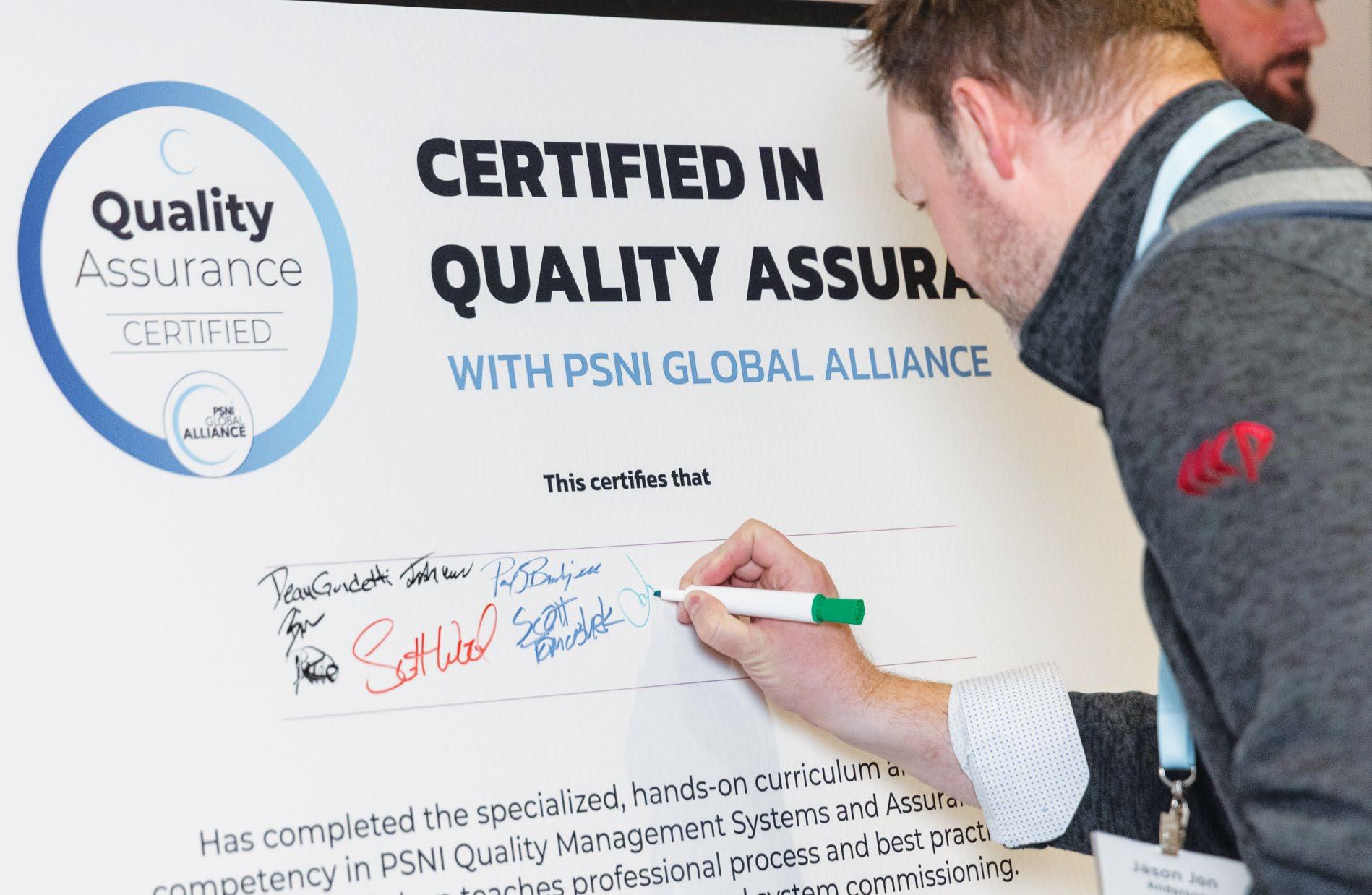
PSNI Global Alliance has launched a new Quality Assurance Certification (QAC). The exclusive program is designed to empower its network of Certified Solution Providers (CSPs) with advanced quality assurance knowledge, ensuring standardized excellence across global AV projects.
Developed in collaboration with a committee of leaders from PSNI’s CSP companies worldwide, and based on the AQAV (Association for Quality in AudioVisual Technology) AV9000 standard, the QAC merges quality principles with real-world business applications. By leveraging core concepts from the AV9000 quality documentation process, the certification fosters a culture of continual improvement and technological precision.
Tailored for professionals in technical field operations, system design, service management, and installation, the QAC course delivers a two-day, interactive workshop format, concluding with a Q&A assessment. The inaugural QAC course took place March 31-April 1 in Atlanta, ahead of PSNI’s annual Supersummit.
“This new certification is yet another way we are ensuring that every CSP in our network operates at the highest level, delivering unparalleled service and expertise,” said Chris Miller, executive director of PSNI. “A customer of one CSP is a customer of all, and with this certification, our CSPs gain an edge that no one else has: a globally unified approach to excellence in AV service and support.”
HARMAN Professional Solutions was recently awarded the Joint Interoperability Testing Command (JITC) certification and listing on the U.S. Department of Defense Information Network (DoDIN) Approved Products List (APL) for 19 products. The certified products include AMX N2600 AVoIP encoders and decoders, N4321D audio transceiver, UVC1-4K HDMI to USB capture device, MUSE Automation Controllers, Varia Touch Panels, and CE I/O extenders.
JITC certification is a crucial requirement for technology solutions used in U.S. government facilities. The certification ensures that HARMAN products meet strict security standards and can
seamlessly integrate with other systems used by the DOD. The certification process includes a thorough evaluation of a product’s security features, performance, and interoperability.
“Meeting and surpassing the stringent security demands of our most critical government, military, and corporate customers has always been a core design priority. This commitment has positioned HARMAN as a leader in the AV industry for delivering highly secure AV solutions,” said Jamie Trader, VP, installed AVC, HARMAN Professional Solutions.
SAVI Controls and OliverIQ have announced a strategic merger. The newly formed company will operate as SAVI iQ and will deliver AI-driven, cloud-based automation and a support platform for commercial and residential markets.

SAVI iQ plans to bolster its product line with AI-powered cloud services for commercial projects from bars and restaurants to casinos and sports stadiums. ISPs and security partners can now extend services beyond residential subscribers to commercial customers.
The company delivers an AI-driven automation platform built to scale, with built-in, always-on remote management as a service, enabling partners to remotely control, monitor, update, and troubleshoot projects from anywhere. This simplifies programming and installation while increasing profitability for integrators and service providers.
Key to this transformation is Ollie, an intelligent automation agent that recognizes patterns, optimizes performance, and proactively resolves potential issues. By reducing support calls, Ollie enables dealers and commercial integrators, Telcos and ISPs, builders, and security providers to focus on delivering customer experiences while minimizing costs.
“Our solution harnesses AI and intuitive voice controls, enabling our partners to scale operations and unlock recurring revenue opportunities,” said John Dorsey, president of SAVI iQ. “The cost of commercial AV systems and system design have been prohibitively high and overly complicated for decades. Together we are providing clients with the most advanced solutions and a recurring revenue service model that transforms their bottom line.”

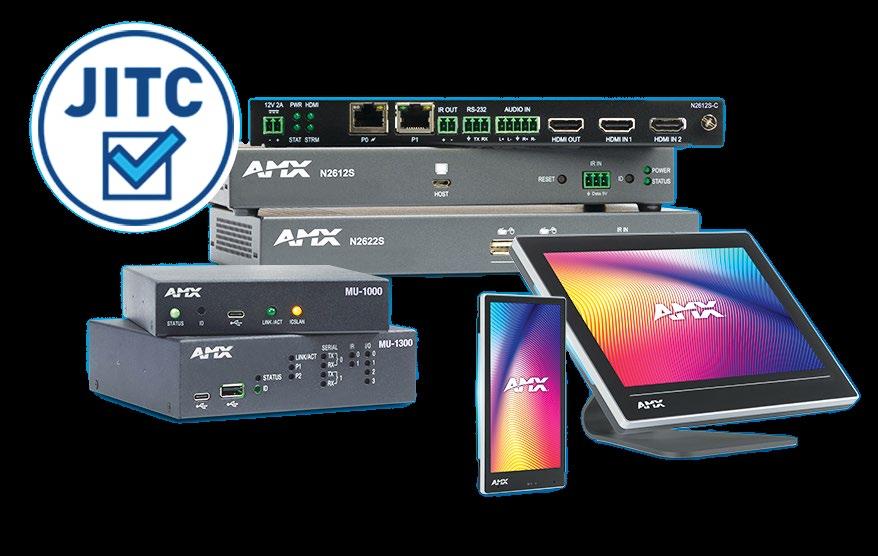


Vibrant,
By Wayne Cavadi
AVI Systems is ready to usher in a new era. Announced at its annual Global Sales Summit on April 22 in Dallas with approximately 330 staff and nearly 300 partner attendees present, the integrator announced a rebranding to the name FORTÉ.
“We have become much more than an AV systems integrator,” Jeff Stoebner, CEO, FORTÉ, told SCN. “In recent years, we made a series of major investments to grow the business’s capabilities and expanded office locations to serve every major market in the U.S. We’ve also expanded our global deployment capabilities, created robust managed services offering, developed five innovative practices areas with deep industry expertise, and we’re able to deliver solutions with unmatched speed with our Velocity solutions. Due to our expanded capabilities, we’ve become a strategic partner, helping our customers transform their modern workplace.”
As Stoebner explained, the new name was the right fit. One meaning of FORTÉ, for example, is the greatest strength or area of expertise. “We feel it’s a perfect description of our unmatched expertise in designing, deploying, and supporting communication and collaboration solutions,” he said.
However, the word also carries another meaning: to play a particular note or passage in a musical score loudly, which also fits the new bold vision for the integrator. “We feel the new name and logo are bold,” Stoebner added. “We wanted a logo that also exudes confidence. The font choice with the accent mark on the E is easily identifiable. The color palette that surrounds
the O recognizes our legacy brand colors with a modern update. The new FORTÉ logo exemplifies who we are as a company: bold, vibrant, and confident. We’ll never stop evolving to make sure our customers succeed.”
With the shift, FORTÉ is moving its focus outside the Pro AV integration box, with a more holistic view of the industry, removing the blinders that may pigeonhole an integrator from truly addressing what customers need. The goal, said Stoebner, is to help organizations view their entire AV and UCC estate as an ecosystem that functions at a high level.
“The innovative solutions we create are the confluence of people, spaces, and technology— enhancing every employee touchpoint,” Stoebner added. “We bring seamless collaboration to life, keeping the modern workplace, classroom, and government agencies connected and helping people remain productive. Every solution we deploy and manage functions flawlessly with existing IT infrastructure ensuring secure, reliable, and future-ready systems.”
Part of this new direction comes from listening to 50 years of customer engagement. Despite all the success stories, there is no denying that the needs and expectations have evolved, especially in the post-COVID workplace. Long-time customers are rethinking their spaces, everything from conference rooms to flex spaces, large training rooms, and multi-purpose areas for all-hands meetings Stoebner observed.
“Every space requires collaboration solutions and the right technologies to enable people to be productive,” he said. “FORTÉ is positioned as a strategic partner in this transformation. We’re so much more than a technology systems integrator or vendor.”
Prospective customers can expect the same from FORTÉ, which Stoebner describes as uniquely positioned to help them with technology early in the
process. “From pre-configured meeting room solutions delivered and installed in as a few as 10 days to the custom designs that require expertise only our solution architects can deliver, we simply have the bench strength to be that go-to expert. And we’ll provide the advice and counsel organizations need to understand the ecosystem each solution is designed to support,” he noted.
While the name and logo may have changed, the focus on customer demands has not. For example, the Velocity Logistics Center—opened last June in Dallas by AVI Systems—will continue to address what organizations require. With the help of the center, the company delivered more than 1,000 preconfigured room solutions in its first year of operation, and Stoebner anticipates quadrupling that number this year.
“Demand will determine how we ramp our staff and resource capabilities. It’s something we monitor very closely,” he said of Velocity. “Whether a customer needs one meeting room solution or 1,000 rooms, we’ve developed a delivery model for pre-configured, certified solutions to meet their demand. We have a catalog of solutions and customers can bring us their room standards, which we’ll certify, deliver, and deploy.”
As Stoebner explained, leaders in the workplace and IT want to take what could be complex and make it simple. Technology should forge a path to success, not hinder it. Now, FORTÉ, is partnering with organizations to help them imagine and create solutions that drive real results.
“It’s important to understand that our new brand identity will carry our company well into the future, no matter what happens in the AV or systems integration industry,” Stoebner concluded. “While communication and collaboration solutions and services are instrumental to our business today, we know this will evolve. Artificial intelligence is certain to continue playing a role in how people work and interact. On top of this, the continued demand for efficient hybrid work solutions, customer experience solutions, technologies in the retail space that engage with audiences, smart building solutions—these are all pathways that will ultimately continue to drive our business at FORTÉ, and we intend to be the go-to expert when any organization starts to think about how to enhance their communication and collaboration capabilities.”
“We feel it’s a perfect description of our unmatched expertise in designing, deploying, and supporting communication and collaboration solutions.” Jeff Stoebner, FORTÉ


LG Electronics and Mercedes-Benz Stadium, home of the Atlanta Falcons and Atlanta United, have announced a multi-year partnership that includes the installation of hundreds of new LG dvLED and LCD displays throughout the venue. Meanwhile, LG has delivered a main LED videoboard and more for Fenway Park, the home of the Boston Red Sox and the
oldest ballpark in Major League Baseball.
As part of an ongoing stadium-wide display technology refresh ahead of the 2025 Club World Cup and 2026 FIFA World Cup, LG displays are now being installed across multiple areas of Mercedes-Benz Stadium, including concourse areas and clubs. The standout addition came in February, a 98-screen pitch
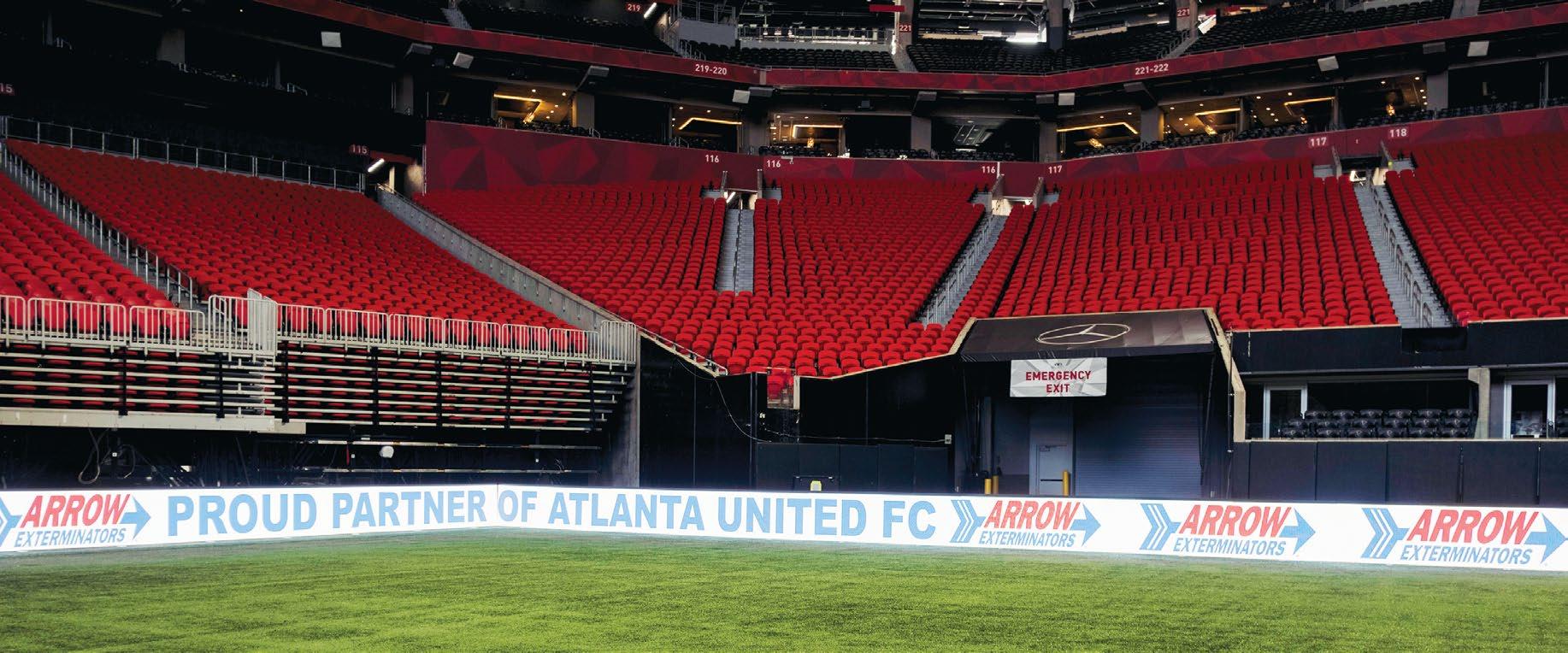
The Seattle Mariners have a newly upgraded production control room at T-Mobile Park, courtesy of Diversified. The new setup enables the Mariners to present games and players in dynamic new ways, giving fans more to cheer about and boosting the home field advantage.
“We take pride in delivering the best fan experience, not just in the Pacific Northwest or in baseball, but across all sports venues,” said Ben Mertens, VP of creative and content services for the Mariners.
“Working in partnership with Diversified, we built a control room that delivers today and sets us up to keep innovating with new and exciting opportunities for fans at T-Mobile Park in years to come.”
The new control room design prepares the Mariners for future upgrades while providing an improved production experience for control room operators. “The new setup not only streamlines our operations, it gives us room to grow as the fan experience keeps evolving,” explained Anny Patrick,
LED ribbon that provides a field-level backdrop for all Atlanta United Home matches.
Tom Bingham, LG Electronics USA’s B2B vertical markets director, said the ribbon features a unique technology over each display that helps protect the screens from impact. It’s also portable, so it can be stored between matches or used for other events where field level signage is required.
In late March, LG installed a 100x38-foot videoboard in centerfield at Fenway Park, as well as 11 digital signage screens that span a combined area of more than 9,000 square feet. The new displays were ready for the team’s home opener against the St. Louis Cardinals on April 4.
With a focus on redefining the fan experience, LG has established a strategic partnership with ANC, the agency managing stadium operations and advertising on behalf of Fenway Sports Group, the owner of the Boston Red Sox. Troup Parkinson, chief marketing and partnerships officer for the Boston Red Sox, said the collaboration will elevate the in-venue experience for fans.

senior manager of video operations for the Mariners. “As we continue to innovate our game presentation, these upgrades give us the ability to connect in new ways with our fans.”
The upgraded control room features an IP-based system with a new router orchestration from Imagine Communications, video switcher, cameras, graphics machines, control panels, and Riedel intercoms. Improved resources and connectivity support higher-res displays and high dynamic range color space, matching the Mariners’ creative ambitions. Expanded camera gear now allows for more dynamic coverage, helping capture the energy of the game and highlight fans across the ballpark and beyond.
“Our relationship with Diversified spans more than a decade, beginning with our last major control
room upgrade,” said Mertens. “This project is the latest milestone in a long legacy of collaboration to bring the best atmosphere in baseball to T-Mobile Park. We are very thankful for Diversified’s continued support and role in making sure our control room has the best tools available to do the job.”
“This wasn’t just about upgrading technology—it was about amplifying the energy of T-Mobile Park,” said Lane Baird, account executive at Diversified. “The Mariners now have more powerful tools to tell their story, celebrate their players and connect with fans in real time. That kind of engagement fuels a gamechanging home field advantage, and we’re proud to help make that possible.”

The Jack Breslin Student Events Center, a multipurpose arena at Michigan State University in East Lansing, has been a hub of activity since its opening in 1989. The arena underwent a renovation last year that elevated its AV capabilities to new heights, made possible by designer and MSU technology consultant Anthony James Partners and the collaboration between SNA Displays and LynTec.
SNA Displays achieved two significant milestones at the Breslin Center. The renovation featured the company’s first seamless center-hung videoboard. Four slightly convex 4mm BOLD Interior LED screens were joined to create a continuous 360-degree viewing experience. Unwrapped, the display is 14 feet high and 104 feet wide. SNA Displays also introduced a seamless ribbon display, a 4-foothigh, 728-foot-long, 10mm LED installation that wraps around the entire arena bowl.
Behind the displays lies the essential yet often overlooked role of power control. LynTec provided the power management infrastructure required to support
the project’s ambitious technological advancements. The Breslin Center project presented an added layer of complexity due to the scale of the displays and the requirement for compatibility with V3Pro, SNA Displays’ proprietary control software.
To address these challenges, LynTec delivered a customized solution. A LynTec LCP 342 main breaker panel provided centralized power control for the system, while a separate LCS 342 panel was installed directly within the center-hung to enable localized control.
In all, the center-hung is powered with 16 threephase 20-amp and eight three-phase 30-amp circuits, while the ribbon is supported through 12 208V single-phase circuits. The solution also includes a manual switch panel, giving on-site technicians the ability to control specific zones, if needed.
“Typically, ribbons of this pixel pitch and this resolution have to use a lot more power and need a ton more circuits,” said David Kile, senior director of solutions at SNA Displays. “Working with LynTec on
multiple projects, we’ve learned how to make it as efficient as possible. The fact that it is over 700 feet with incredible resolution and pixel pitch only running on 12 circuits is an incredible feat.”
An additional secondary LCS 342 three-phase panel and multiple XPC rack-mounted controllers were deployed to establish communication between LynTec’s power control software and V3Pro, which allows operators to control power remotely from a single interface, eliminating the need to switch between multiple platforms. The integration also extends to Ross DashBoard monitoring software, further enhancing operational flexibility for broadcast applications.
“We’ve built a strong relationship with LynTec over the years, beginning with Lucas Oil Stadium, and it’s only grown stronger with each project,” Kile added.
“Their panels are reliable and intuitive, and their team has worked closely with us to ensure our software solutions integrate seamlessly. For operators, this means they can power displays on and off without jumping between multiple systems.”



The city of Norman, OK, has selected RGB Spectrum to deliver a video processing and control system for its new traffic management center. The innovative venue will replace the traditional front-of-room screen with personal console-based video walls, setting a new standard for operational efficiency.
At the core of the deployment is RGB Spectrum’s Zio 4000 series video processor, XtendPoint KVM over IP, and RGB Rack PCs, enabling seamless, customized workflows to operators. Designed in partnership with global engineering and design firm Stantec, the new system redefines what’s possible in compact, efficient traffic management environments.


“Norman’s commitment to cutting-edge technology ensures we can effectively monitor traffic patterns and enhance safety for all who live, work, and travel through our city,” said David R. Riesland, Norman’s city transportation engineer.
“This project has been over 15 years in the making, and it’s incredibly rewarding to see that long-time vision finally become reality. We’re excited to partner with RGB Spectrum to implement a best-inclass solution that supports our mission.”
The new 2,300 square-foot facility will be transformed from a shell space into a highly functional center, including three offices, an operations room, and an IT room. Within the operations space, four operators oversee five discrete networks—ranging from ATMS/ITS and
enterprise to public safety, security, and web administration—through a fully distributed architecture. Each operator will have access to five dedicated Rack PCs located remotely in the IT room, allowing for quiet, clutter-free workstations and centralized maintenance.
Using RGB Spectrum’s XtendPoint KVM over IP with multiview capability, operators control and interact with any PC across any network from their consoles. The upper displays at each station serve as personalized video walls, dynamically combining a mix of sources. Each operator can mirror a common display layout or configure their own unique, task-specific view.


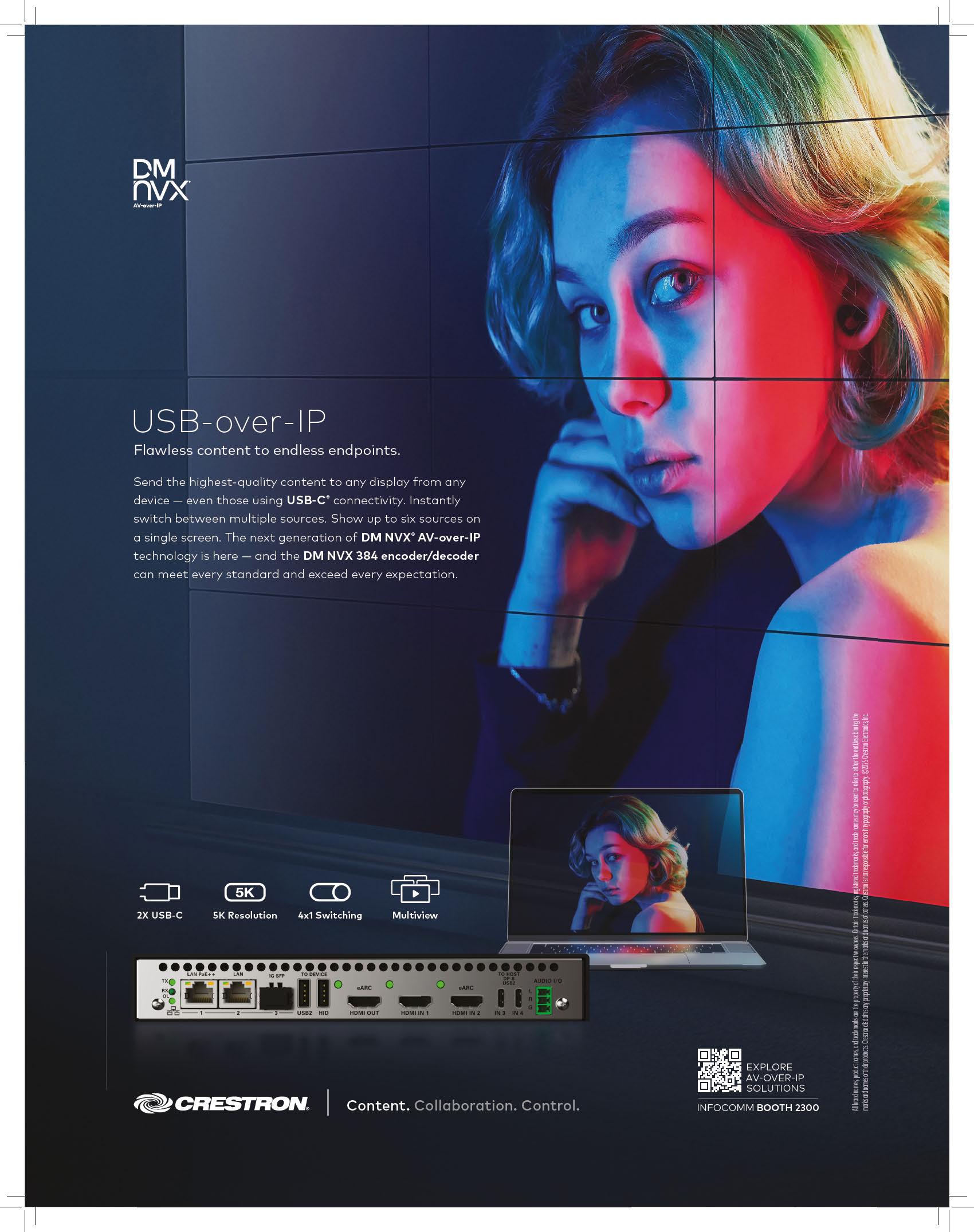
CTI has acquired LightWerks of Carson, CA, a move that expands the company’s current operations in Los Angeles, Orange County, San Diego, and the San Francisco Bay Area, while bringing Boise, Idaho, and Montana into CTI’s coverage for the first time. CTI serves customers worldwide as a member of the PSNI Global Alliance and across the U.S., with locations from Michigan to Texas and New Jersey to California.

Dallas’s Southern Methodist University (SMU) has upgraded its Emergency Operations Center (EOC) with a series of fine pitch LED displays, all driven by a tvONE CALICO PRO video processor. The EOC is the hub for security for the entire facility, including the university’s in-house fire, police, security, ambulance, and cameras.

“Over the last 25 years, LightWerks has quietly built an enviable reputation in some of the most difficult markets in the United States, dazzling clients across a host of fields,” says John Laughlin, CEO of CTI. “The customer testimonials on LightWerks’ website describe a company that matches CTI’s premium on top-shelf service, relationships that last decades, and the ability to listen and deliver what the client needs. I’m honored to bring the LightWerks team into CTI and look forward to the experience and relationships they bring to our West Coast operations.”
Three screens were installed by UberDisplays, in collaboration with AV technology partner Digital Resources, which oversaw the project. “The creation of a new EOC for SMU provided the opportunity to have all operating systems in one location, and the video processing solution needed to be robust and reliable, which is why we turned to tvONE and the new CALICO PRO,” said Andrew Rice, chief revenue officer, UberDisplays. “The installation required 20 separate inputs, which we needed to replicate to three separate walls.”
The crisis management function provides a coordinated response to emergencies involving the use of resources from the university, federal level, state level, or local authority. SMU has established the
Metinteractive has furthered its relationship with the University of Connecticut (UConn) at Storrs by upgrading AV systems at the Gampel Pavilion basketball facility to deliver an improved fan experience. It’s the latest of several projects Metinteractive has completed with UConn. “Gampel Pavilion is part of the continuing effort to standardize and connect facilities across all sports on the UConn Storrs campus,” explained Jeff Mele, Metinteractive’s chief commercial officer and project executive for Gampel Pavilion. “Facilities that are fragmented often require more support and more initial capital expenditures due to their individual, complete systems. Although standardization and connectivity add complexity, the long-term results are lower costs and greater operational flexibility.”
Metinteractive installed fiber to connect the control
room to two new large Daktronics LED videoboards mounted at each short end of the court, and integrated a Ferrofish Pulse16 MX AD/DA converter with the displays’ video content. The integrator also updated Gampel Pavilion’s existing broadcast system to enhance the university’s live production capabilities. The control room was outfitted with two large ElationLogic monitors, Ross Ultrix router and XPression graphics system, Evertz DreamCatcher DC-ONE replay platform, and a master clock for AV synchronization.
EOC framework consistent with Department of Homeland Security, National Incident Management System, and the Texas Division of Emergency Management involving SMU emergency responders and local authority.
The EOC will be run by SMU and its video staff on a day-to-day basis. “We worked closely with Scott Kehoe from tvONE to rig the system and provide training on site,” Rice added. “tvONE are always responsive and the training was complete in two days—it was amazing. One of the biggest successes of the project is that using the CALICO PRO, all the cameras from the entire campus can be shown on the displays at any time, which is very impressive.”
“The SMU EOC was a great project to work on, and it’s great to see the CALICO PRO’s features being used for such an important center at the school,” said Kehoe. “We designed the CALICO PRO from the ground up, creating a solution for a wide range of video processing applications with new features for easier and faster installation of complex direct view LED walls. The results at the EOC are great.”

majority of UConn’s on-site AV game support.
Plus, it tied Gampel Pavilion to the Rizza Performance Center’s control room, enabling a second basketball show to be produced there when Gampel Pavilion’s control room cannot accommodate people shooting for in-house and major broadcast simultaneously. Metinteractive also supplies the
“The new graphics, lighting, and videoboards have truly transformed the venue, and the improvements are already making a noticeable impact,” said David Benedict, director of athletics, UConn.
“Metinteractive’s attention to detail and dedication to enhancing the experience for everyone who visits Gampel is evident in every aspect of the upgrade. We’re excited to see the positive effects these updates will have on both fans and teams alike.”

By Sean Wargo
The tariff uncertainty continues to remain a top concern within the Pro AV industry. Over the past three months, the AV Sales Index (AVI-S) has consistently shown expansion. March saw the highest growth, with a slight moderation in April. Despite the small dip from March (60.9) to April (59.7), the overall trend remains positive,
The impact of federal layoffs and tariffs are expected to have broader effects in the coming months.
indicating sustained growth in the sector.
The AV Employment Index (AVI-E) bounced back in April to 55.5 from 53.5. The AVI-S and AVI-E continue to show modest growth of the industry. The U.S. economy added 177,000 jobs in April, exceeding the expected 138,000, but the government revised previous months downward. March’s figure was adjusted to 185,000, while February’s was revised down even more sharply to just 85,000 new positions.
This suggests the labor market hasn’t been quite as robust as initially reported. Unemployment remains at 4.2%. The impact of federal layoffs and tariffs are expected to have broader effects in the coming months.
“We are not doing layoffs. Rather we are choosing to delay replacement hires until the

economy picture is clearer,” shared an AV integrator in North America.
“Clients are withholding commitments due to economic transition and uncertainty. Tariff concerns with price and supply is high,” commented an AV Integrator in APAC.
The Pro AV Business Index report is derived from a monthly survey of the AVIXA Insights Community, a research community of industry members that tracks business trends in commercial AV. The report comprises two diffusion indexes: the AV Sales Index (AVI-S) and the AV Employment Index (AVI-E). In each case, an index above 50 indicates an increase in sales or employment activity. For more information about joining the AVIXA Insights Community, visit www.avixa.org/AVIP.
Sean Wargo is the VP of market insight for AVIXA.
Put the power of uncompressed UHD Fiber Optic Extension in the palm of your hand with DVIGear’s new DVI-7318 — a high performance 4K/60p Optical Extender that transmits high resolution HDMI signals over long distances using a single fi ber optic cable.
• Extends HDMI 4K/60p signals up to 1000 ft. (300m)
• Supports resolutions up to 3840x2160 /60p (4:4:4)
• Supports HDMI 2.0 and HDCP 2.2
• Includes EDID Learn and Caching
• Can be powered by local USB port

• Uses a single Multi-Mode fiber
• Compact Rugged Enclosure










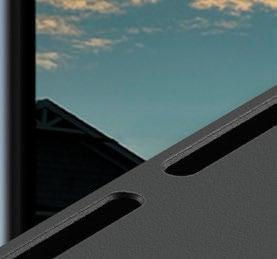
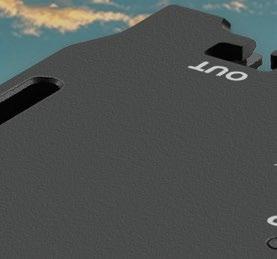








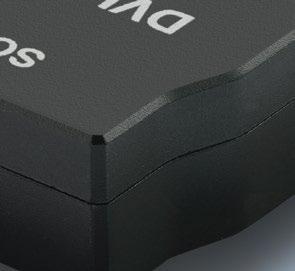
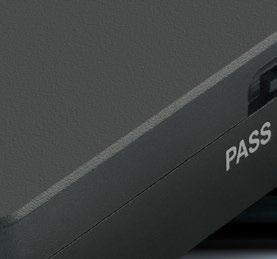
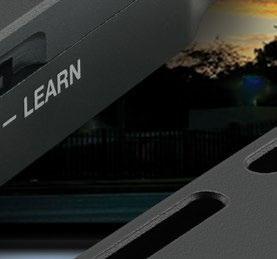




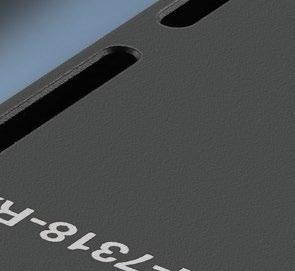



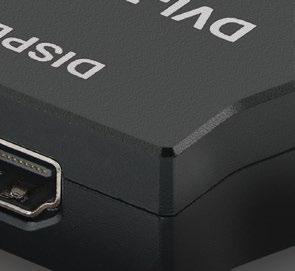








By Mark J. Pescatore
SCN: What made you decide to start MSolutions?
Eliran Toren: After five-and-a-half years at Valens, I felt ready to move into a new phase of my professional career. My work at Valens required excessive travel, and over that time I developed strong industry relationships. That included hundreds of installers and dealers, and I learned their pain points. In the process, I developed an abundance of ideas that would help them better address their needs and solve problems along the way. I started MSolutions to coalesce these ideas around a vision that would bring affordable, problem-solving solutions to AV installers.
SCN: How important has your previous experience at Valens been to the development of MSolutions product lines?
ET: My time at Valens, where HDBaseT was invented, instilled a strong knowledge of the foundational elements within the infrastructure as well as the possibilities it enabled for in-room AV connectivity. I understood what HDBaseT offered for the convergence of uncompressed video, audio, data, and more over longer distances, and the value that brought inside spaces such as meeting rooms, classrooms, and auditoriums, including a streamlined cabling infrastructure that reduced costs and clutter. That started with the extenders.
SCN: There are several distribution protocols out there, so why are you sold on HDBaseT?
ET: Beyond its foundational capabilities outlined above, the advances that come with HDBaseT 3.0 open up new technological opportunities for MSolutions. We have more bandwidth to work with and that allows us to be more creative on the product development side. We have 18 Gbps versus the 10 Gbps ceiling of HDBaseT 2.0 and AV over IP. And we do have an AV over IP product line that will continue to grow. For dedicated spaces, and especially those designed as collaborative environments, HDBaseT 3.0 has much more to offer for everyone through to the end user.
SCN: What makes your TestPro products stand out?
ET: The most important takeaway is that the MSTestPro is the only test solution approved by the HDBaseT organization. It is a handheld device that gives installers direct access to important parameters related to system performance. That includes the presence and quality of AV signals moving through the system, as well as the structural integrity of the cables that carry these signals. The results are displayed on a
GUI and provide installers immediate understanding of what actions, if any, are required.
Another important feature is that the MSTestPro is an all-inclusive solution to support the testing, analysis, and certification of HDBaseT, HDMI, USB, and DC resistance, with modules specific to each that attach to the tester. Our newly enhanced UCT module is the AV industry’s only dedicated solution for qualifying USB-C cables and interfaces, verifying wire mapping, USB version compliance, alternate mode support, data lane structure, and power delivery. This is an important value-add with the increased presence of USB-C in meeting and learning spaces.

SCN: You test and manufacture cables—so what’s the secret to building a reliable professional cable?
ET: We supply a cable with every device we manufacture. When we sell a USB extender, it’s important that we provide the installer with the correct corresponding USB cable. The USB world is very complex, with many different versions and specifications. Buying an off-the-shelf USB cable can be a gamble for compatibility as well as structural integrity. We build all our cables to exacting specifications. There are no missing wires and no shorts on the connectors.
SCN: What bad habits should AV professionals avoid to help their cables last longer?
ET: The testing needs to be thorough and needs to be done across the entire system. It amazes us to this day how many systems go remarkably undertested. Confirming the presence of an image will not tell the entire story. If the image is on the edge of failure, something as simple as turning on the air conditioner or lowering the shade can result in loss of image. Our modules attach directly to the cable, which makes it easy to test cable integrity at very precise points.
SCN: How important has USB-C become for the Pro AV industry?
ET: USB-C will fully dominate in the coming years. USB-C has the power to carry everything needed in an AV environment over a single wire, with the added simplicity of a small connector. There is less ongoing expense in comparison to HDMI. The latest signs of USB-C domination is the inclusion of USB-C ports on

Eliran Toren
Position: CEO
Company: MSolutions
displays from companies like Lenovo. As more USB-C ports are added to displays, you’ll see HDMI connectivity gradually fade from view over time.
SCN: Speaking of USB-C, I saw a new meeting room connectivity solution at your ISE 2025 booth. What makes the MS-63DOC unique?
ET: It all comes down to simplicity. The MS-DOC63 is at the core of our 1Connect meeting room ecosystem, which more specifically is anchored through the MS-63DOC Docking Extender Kit. That kit pairs host and device MS-DOC63 units for AV and USB transport. On the front end, a single USB-C cable connects the originating source, such as a presenter’s laptop, to the local MS-63DOC host device.
The host unit acts as a docking station gateway, maintaining single-cable efficiency by moving all signals (including control) to an MS-63DOC device unit over Category cable. The device unit functions as a robust docking extender and unlocks all connections to destinations on the back end. Those connections can include up to two displays (via HDMI), a USB or PTZ camera (via USB 3.2 or USB-C connections), and a digital or analog audio speaker output.
The MS-DOC63 is instrumental as to how 1Connect seamlessly unifies AV and USB signals on the front end while delivering unmatched flexibility and integration on the back end. At InfoComm, we will introduce the MS-63DOC-P unit, which offers the same functionality plus 60 watts of device charging.
SCN: MSolutions also has KVM solutions, so I have to ask: Are you Team Traditional KVM or Team KVM over IP?
ET: We remain both proponents and suppliers of both. Smaller meeting spaces, classrooms, and huddle rooms need point-to-point connections. That is all that is needed to do the job, because the spaces are small and the technology requirements are minimal. KVM over IP can be useful for larger meeting spaces with more IP networking needs, but its real value is for facilities with 50 or more meeting spaces. That’s a sound threshold for making that leap.
SCN: What’s next for MSolutions?
ET: We are actively building out a business infrastructure in North America that is anchored through a distribution channel. Stirling Communications has been a strong partner for us in the Northeast and Mid-Atlantic. We are continuing to build our North American structure to include more dealers.
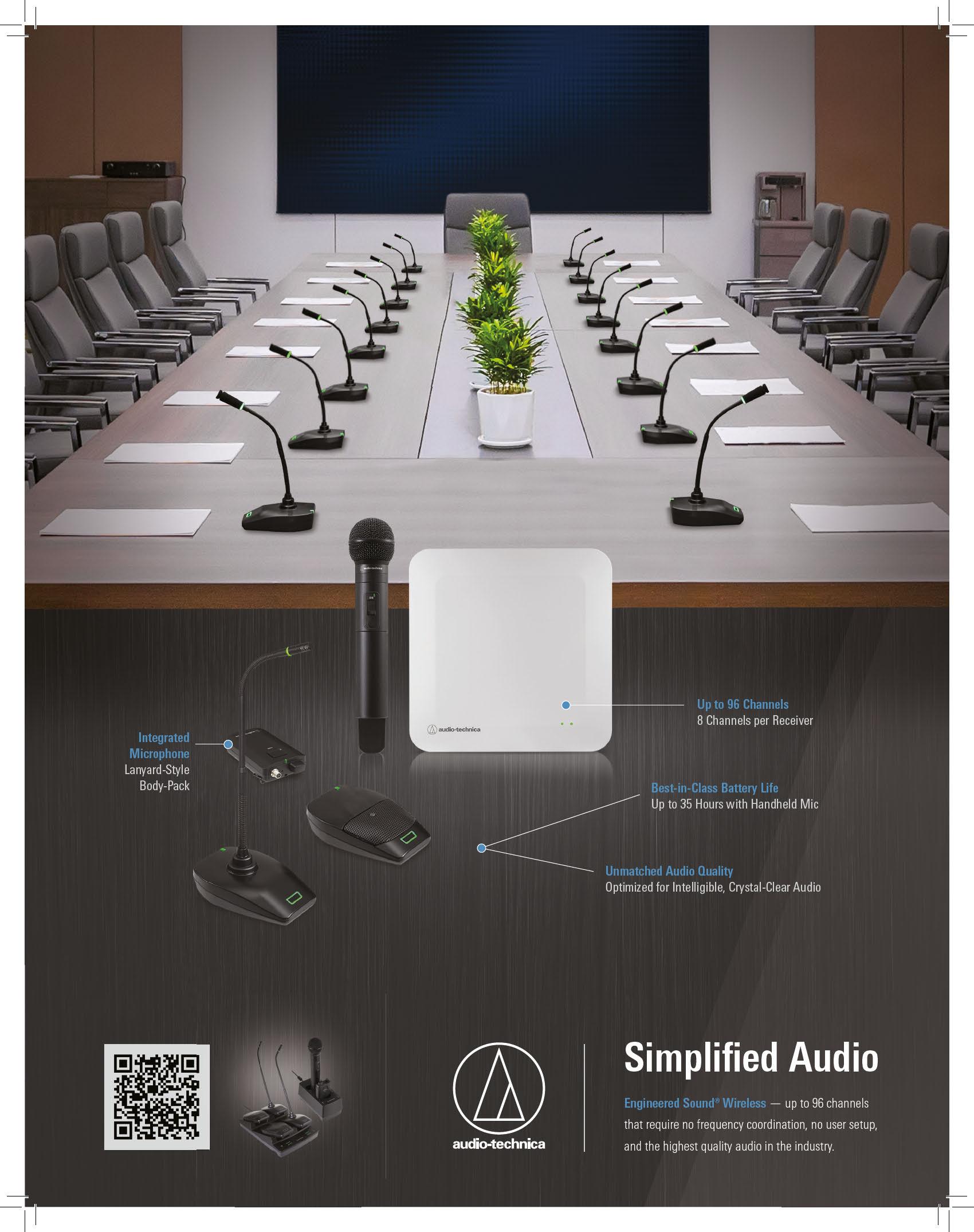
Farmingdale, NY-based GROUP ONE LIMITED, the U.S. distributor for several pro audio and lighting brands, has added PLUS FOUR MARKETING to its independent manufacturer’s representative network.
Headquartered in Walnut Creek, CA, Plus Four is under the direction of principal Joe Mathews, son of the late James “Jimmy” Mathews, who founded the firm more than 40 years ago. Plus Four will facilitate sales and support for the DiGiCo, Fourier Audio, KLANG, MC2, Sound Devices, and XTA lines throughout Northern California, Nevada (outside of Las Vegas), Oregon, Washington, Idaho, Montana, and Alaska.
NSI’s Network Infrastructure Division has appointed PHOENIX MARKETING GROUP as the company’s national sales representative for its Platinum Tools, LYNN Electronics, TechLogix Networx, and ENET lines in the AV and security channels. PMG currently covers 45 states and focuses on lighting, shades, smart home automation, audio, and video solutions for residential and commercial projects in any environment.
SFM, a Canadian distributor in customized go-to-market solutions for global brands within the audiovisual, pro retail, live entertainment, and media production industries, has been appointment as the exclusive Canadian distributor for BOSCH COMMUNICATIONS SYSTEMS. This strategic partnership grants SFM exclusive distribution rights for Electro-Voice, Dynacord, RTS, and Bosch Conference, and Bosch Public Address throughout Canada.

ACT ENTERTAINMENT has appointed BOB BONNIOL as director of innovation for video. His credits range from Broadway to mega-tours, theme parks to augmented worlds, and he now takes the helm of ACT’s rapidly growing video and interactive technology areas. In this newly created role, Bonniol leads product development, uniting the capabilities of Green Hippo and tvONE under ACT’s innovation umbrella. He aims to expand ACT’s reach and help its clients create new immersive experiences, digital placemaking, and destinationscale entertainment.
ADVANCED SYSTEMS GROUP recently named broadcast engineer and veteran event operations manager JOHN SMART as account executive,

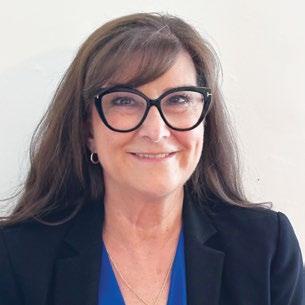
Northern California region. Smart has been with ASG for eight years and joins the account management team. In his new position, Smart brings his experience as a broadcast engineer and operations manager to find solutions that best meet client needs and budget. KC NAJARIAN is the company’s new director of strategic accounts, Southwest. With extensive experience providing customer-focused solutions, Najarian will concentrate her efforts on the broadcast and video production markets. She has worked for Quantum, Grass Valley, and Avid, along with her previous experience at systems integration firms.

KATE GAZDIC has joined BECKTV as a senior procurement specialist. She oversees the procurement aspects of BeckTV’s diverse portfolio, which primarily involves projects related to sports and live events. Gazdic’s experience includes roles at Broadfield Distributing and multiple systems integrators, where she served as inside sales and procurement manager on large projects for the Milwaukee Brewers, Memphis Grizzlies, MLB, and the Carolina Panthers. As a purchasing agent at Gepco International, she managed stadium, studio, and mobile truck projects from pricing to delivery for clients such as Texas A&M and Baylor University.

BLACK BOX appointed JAI VENKAT as the company’s chief revenue officer in the Americas. A member of the executive leadership team, Venkat leads revenue strategy and execution, driving growth, bolstering account management, and accelerating revenue across all industry verticals and horizontal practices. Venkat joins Black Box with more than three decades of experience leading sales, services, and transformation initiatives at global technology firms. Prior to joining Black Box, he held senior executive leadership roles at Allied Digital, Zones, DXC Technology, HP Enterprise, Cognizant, Capgemini, and Infosys.

CELESTION has appointed MATT DAIGLER as business development executive. In his new role, Daigler works together with Celestion’s sales and distribution partners in the U.S. musical instrument category,
the PA service market, and retailers who cater to DIY hobbyists. In addition, Daigler is managing existing OEM relationships and pursuing new OEM partners in the pro audio and high-end home theater markets. His audio industry career started at Westlake Audio as a mechanical assembler, then production manager, and he eventually moved to HARMAN-owned Audax of America, where he worked as a sales engineer.

CHRISTIE appointed HIDEAKI TAKIZAWA as the new CFO of Christie and its subsidiaries. Takizawa aligns Christie’s financial strategy with its overall goals and manages internal controls and reporting to support continued growth and innovation. He brings more than 34 years of experience working at Ushio and a wealth of expertise in business management and finance. Before joining Christie, Takizawa served as general manager of Ushio Group’s Business Management Division.


DIRECTOUT appointed pro audio veteran VAINO GENNARO as the first point of contact for North American customers. With his extensive experience in the pro audio industry and expertise in sales, business development, and customer relations, Gennaro plays a key role in expanding DirectOut’s market presence in the region. In this new role, he is instrumental in further establishing DirectOut’s innovative audio solutions across the country. DirectOut also promoted LORENZO SASSI to head of global marketing and sales.
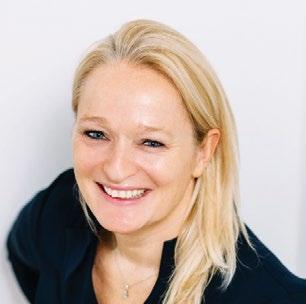

JABRA has appointed SANDRINE DESBARBIEUXLLOYD as SVP of global marketing. In her new role, Desbarbieux-Lloyd leads marketing initiatives for Jabra’s headsets and speakerphones, as well as software and AI-driven videoconferencing solutions. Bringing a wealth of C-level marketing, digital transformation, and AI expertise, Desbarbieux-Lloyd has previously held leadership roles at Meta, Tesco, Samsung, and Avis. She steps into the role previously held by CALUM MACDOUGALL , who has accepted the role of president of the Enterprise division at GN, which holds the Jabra brand.

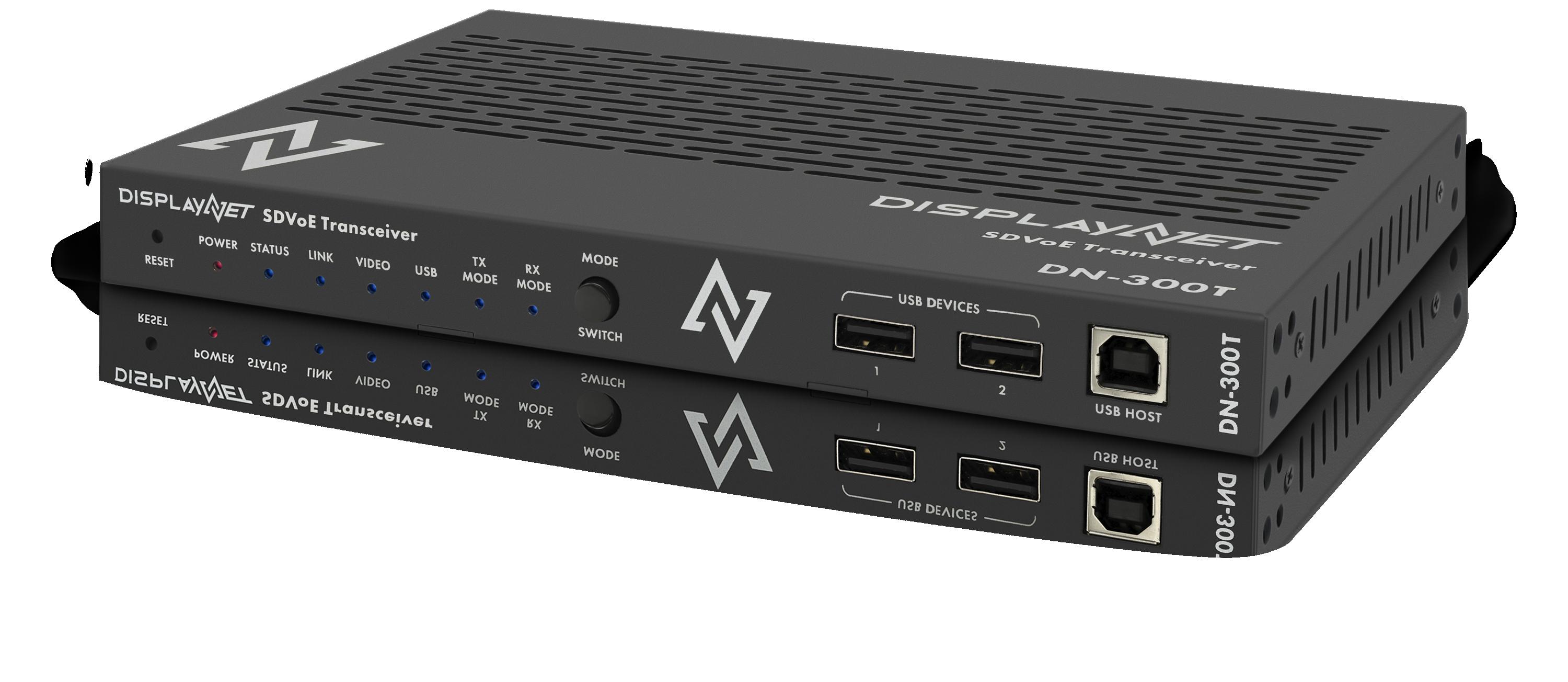
The DisplayNet DN-300 Series delivers an unprecedented level of AVoIP performance, versatility and reliability— at a price point that defines the industry benchmark for value. Based on the latest SDVoE technology, the DN-300 Series provides 4K/60 (4:4:4) video distribution with limitless scalability, zero-frame latency and zero image artifacts.
These units offer unique features that provide system designers with exceptional versatility:
Switchable Transmitter / Receiver operation
Bi-directional Transceiver mode (DN-300T)
Dual (copper / fiber) 10G network interfaces
Long Range: 100 meters (copper), 30 km (optical)
Auxiliary H.264/5 video output streams
Powerful network security features
PoE+ support
Silent, fanless operation
Ultra-compact, rackmountable case
Versatile KVM Routing
DN-300H: USB HID device instant switching
DN-300T: full-bandwidth USB 2.0 routing
DisplayNet also provides software-defined MultiViewer and Advanced Video Wall engines that power a wide range of applications without the expense and complexity of ancillary products. A highly intuitive web-based UI and API greatly simplifies setup and installation, as well as integration into third-party control systems.
Contact us today to see how DisplayNet can move your next AV system into the future.
sales@dvigear.com
(888) 463-9927
www.displaynet.com


















By Steve Greenblatt
decisions, taking risks, and sometimes going against the grain to pursue opportunities that others might overlook (or doubt exist).
All businesses experience ups and downs. This is the nature of business and the fundamental science behind how the economy operates. It can be tempting to focus solely on the highs, positive results, and future opportunities. However, how owners and leaders manage adversity determines the resilience and longevity of the business.
Owning and running a business is not for the faint of heart. Small business owners invest their entire lives into their ventures, including, but not limited to, their time, money, and mental focus. Those committed for the long haul do what is necessary to protect and care for their teams, do right by their clients, and nurture and safeguard what they have built. For founders especially, their businesses are like children they have guided from infancy, making selfless sacrifices to support their development for the benefit of the organization and all those it impacts.
For an owner, the day-to-day management of a business can be likened to being a professional sports gambler. With each day and every decision, business owners and leaders are betting on themselves and their team to deliver value for their investment. While the best professional gamblers may win only 53% of the time to be successful, businesses require a higher win rate to cover costs, reward their team, maintain reserves, reinvest for future needs, and achieve profitability to see a return on their investment.
While non-business owners may rely on financial accounts or other vehicles to build wealth, most small business owners have the majority of their assets tied up in their business. Therefore, the need for profitability impacts not only the business and its team members but also the personal well-being of the owners and their family’s future.
The AV industry offers ample opportunities for entrepreneurship. Whether as a sole proprietor or by building a team, skilled AV professionals who take the leap into self-employment leverage their confidence in their knowledge and skill sets, along with their unique perspective on delivering services and solutions.
What many may not realize when establishing themselves is that achieving success in business involves more than being a skilled technical professional and producing quality work. Running a business requires a distinct set of skills, knowledge, and abilities that may not come intuitively to a highly technical expert. This includes self-belief, as well as making critical
Some businesses start with a full head of steam, capitalizing on an innovative idea or addressing a need with pent-up demand. Other businesses build momentum with each successful outcome and gradually develop a loyal following that requires a two-way commitment.
While businesses seek relationships and loyalty from their clients for future opportunities, there is an equal responsibility that businesses have to take care of their clients when they need them. This includes meeting tight deadlines, working on projects that may not be ideal, or prioritizing their clients’ needs when a crisis arises. In each case, the business must serve its clients, even if it means sacrificing its own interests to build trust and solidify a long-term relationship.
Once the initial excitement and honeymoon phase pass, businesses must confront the reality of daily operations, where challenges develop and surprises are commonplace. Whether it’s a project going awry, a team member failing to meet expectations, a client needing priority support, or someone leaving for another opportunity, transitioning from riding the wave of success to facing adversity serves as a wake-up call that distinguishes between a business that is sustainable long-term and one with only temporary achievements.
Every business experiences natural cycles during which it must navigate changes in costs, talent availability, funding accessibility, client needs and spending, pricing fluctuations, and demand for services. Similar to the seasons of the year, businesses follow a natural seasonal pattern.
There are seasons of prosperity (summer) when a business profits, replenishes reserves, and invests in
seasons of transition (spring and fall) where growth or regression loom on the horizon. Navigating through each season is inevitable and an inescapable part of business. Successfully managing this requires the ability to identify the current season, determine how to adapt to it, and predict when the next season will arrive and how to prepare for it.
It’s when the going gets tough, whether enduring a difficult season or navigating unfortunate circumstances, that the commitment and perseverance of business owners and stakeholders are put to the test. As a defining aspect of their role, business owners understand the importance of committing to do what it takes to keep their business running.
This means making difficult decisions regarding costs, personnel, or investments, taking on debt by bootstrapping with their personal funds or relying on family members or investors for support, and achieving more with less by balancing various roles and working tirelessly to strengthen the business. Many business owners go so far as to forgo paychecks during slow periods when their priority is to keep their team employed, care for their clients, and meet their financial commitments.
It may seem that business owners possess power and control over their own destiny, but the reality can be quite different. All businesses face daily struggles, and small business owners are just one bad decision or challenging situation away from jeopardizing what they have built. The mental strength of business owners is constantly tested as they navigate the uncertainty of the business landscape, always needing to think strategically, adapt to change, and anticipate the unexpected.
It’s easy to become enchanted by the highs that being in business can provide. Whether the preferred phrase is “crazy busy” or “slammed with work,” both highlight undeniable success.

It is important to understand that such outcomes don’t come easily and should never be taken for granted because they don’t last forever.
Business owners who recognize that the seasons will eventually change and possess the focus, fortitude, and foresight to prepare their businesses to adapt and persevere through unsettled times will once again have the opportunity to benefit from a prosperous season.
Steve Greenblatt, CTS, is the founder of Control Concepts, Inc., which provides specialized software and services for the Pro AV industry. Contact him at steveg@controlconcepts.net

By Mark J. Pescatore
InfoComm 2025 is right around the corner. Education sessions start June 7, with the exhibit hall open June 11-13 at the Orange County Convention Center in Orlando, FL. SCN spoke with AVIXA’s Jenn Heinold, who joined the organization last fall as SVP, expositions, Americas, to get more details about the upcoming industry event.
SCN: How does InfoComm attendance in Orlando historically compare to the shows in Las Vegas, and are you expecting increased attendees and/or exhibitors in 2025?
Jenn Heinold: Our attendance goal for InfoComm 2025 is 40,000, which will put us back to prepandemic levels. When we are in Orlando, we see more end users from education, houses of worship, retail, hospitality, and enterprise. We’re expecting more than 900 exhibitors this year.
SCN: AI has certainly been the buzzword of record for the past couple of InfoComm shows. Are tariffs going to be the big story at InfoComm 2025, and what other buzzwords do you expect to hear in the aisles?
JH: AI will be top of mind at InfoComm 2025 and beyond. AI is evolving so fast and impacts us all. On the trade show floor, you’ll see AI-powered solutions that enhance efficiency and improve user experiences. In addition, we have an education track focused on AI that will explore its impact on Pro AV solutions, from audio to digital signage. We’ll also discuss critical topics like emerging compliance and security concerns.
In addition, the intersection of AV, IT, and broadcast, especially in the workplace setting, will be a theme and a big content topic for us. Tarriff talk will be unavoidable, but this is why events are so valuable and important for our community. InfoComm will enable us all to come together as we navigate a lot of uncertainty.
SCN: AVIXA TV is coming back for a third year—why is this booth (and its content) important for the industry?
JH: The convergence between broadcast and AV is a growing opportunity for our industry. Studio technology is one of the top five areas of Pro AV investment for corporations, according to AVIXA’s quarterly Market Opportunity and Analysis Report. For many buyers, this space is newer, so it’s critical for them to see working
solutions that are both practical and inspirational. The AVIXA TV Studio is designed to do just that, whether you’re considering launching a podcast, developing marketing content, or delivering a global keynote from a virtual stage. At the AVIXA TV Studio, we’ll showcase everything from low-tech turnkey solutions to fully customizable setups with advanced features.
SCN: What free educational opportunities will be available at InfoComm 2025?
JH: Debuting at InfoComm 2025 is the Spotlight Stage (Booth 4327). This is a dedicated hub for exploring the fastest-growing solution areas in Pro AV, including broadcast AV, digital signage, and more. This spot on the show floor will feature both a stage and networking lounge, providing a forum for in-depth conversations and connections between attendees and solution providers.
The Technology Innovation Stage (Booth 2461) is the destination to learn about trend forecasts from technology managers, manufacturers, and industry leaders. The stage will also host product announcements and demonstrations and inspiring discussions on pushing the boundaries of innovation.
AVIXA Xchange LIVE (Booth 4761) will return for InfoComm 2025. This is an in-person activation of AVIXA Xchange, the unique virtual community for the AV industry. This spot on the trade show floor will host interactive sessions as well as mixers and meetups Wednesday through Friday.
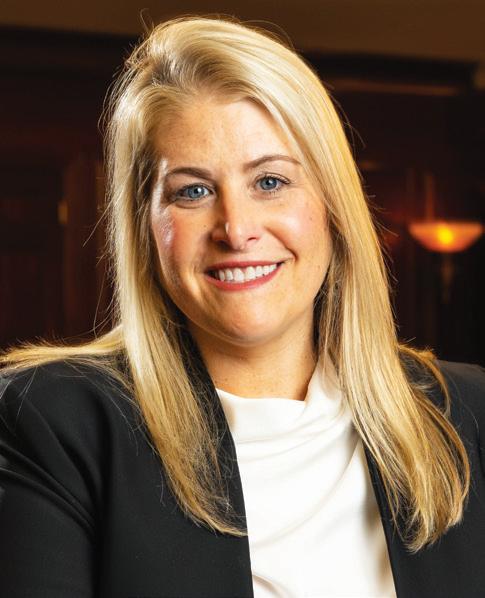
Jenn Heinold
Position: SVP, Expositions, Americas Company: AVIXA
SCN: There was a substantial residential systems component to ISE, which took place earlier this year in Barcelona. There’s always some overlap, of course, but are you considering expanding InfoComm to include a large residential presence?
JH: No, we are not expanding to residential at this time.
SCN: What is AVIXA doing to promote sustainability in Pro AV at InfoComm 2025?
JH: InfoComm will showcase how the Pro AV industry is addressing sustainability challenges, including climate change, resource depletion, and e-waste. Attendees can discover eco-friendly products and solutions and explore sustainable practices in AV design and installation.
We are partnering with SAVe, the first industrywide U.S.-based organization focused on achieving the 2030 Sustainable Development Goals (SDGs), to produce the SAVe Certification workshop. This full-day program covers important information on current sustainability issues, and includes a workshop session to identify ways businesses can address sustainability goals, as well as a planning session to turn ideas into action.
In addition, AVIXA’s Sustainability Advisory Group will host an interactive session at the Technology Innovation Stage exploring the three Ps (people, planet, and profit). They’ll discuss the connection between Pro AV solutions and sustainable design.



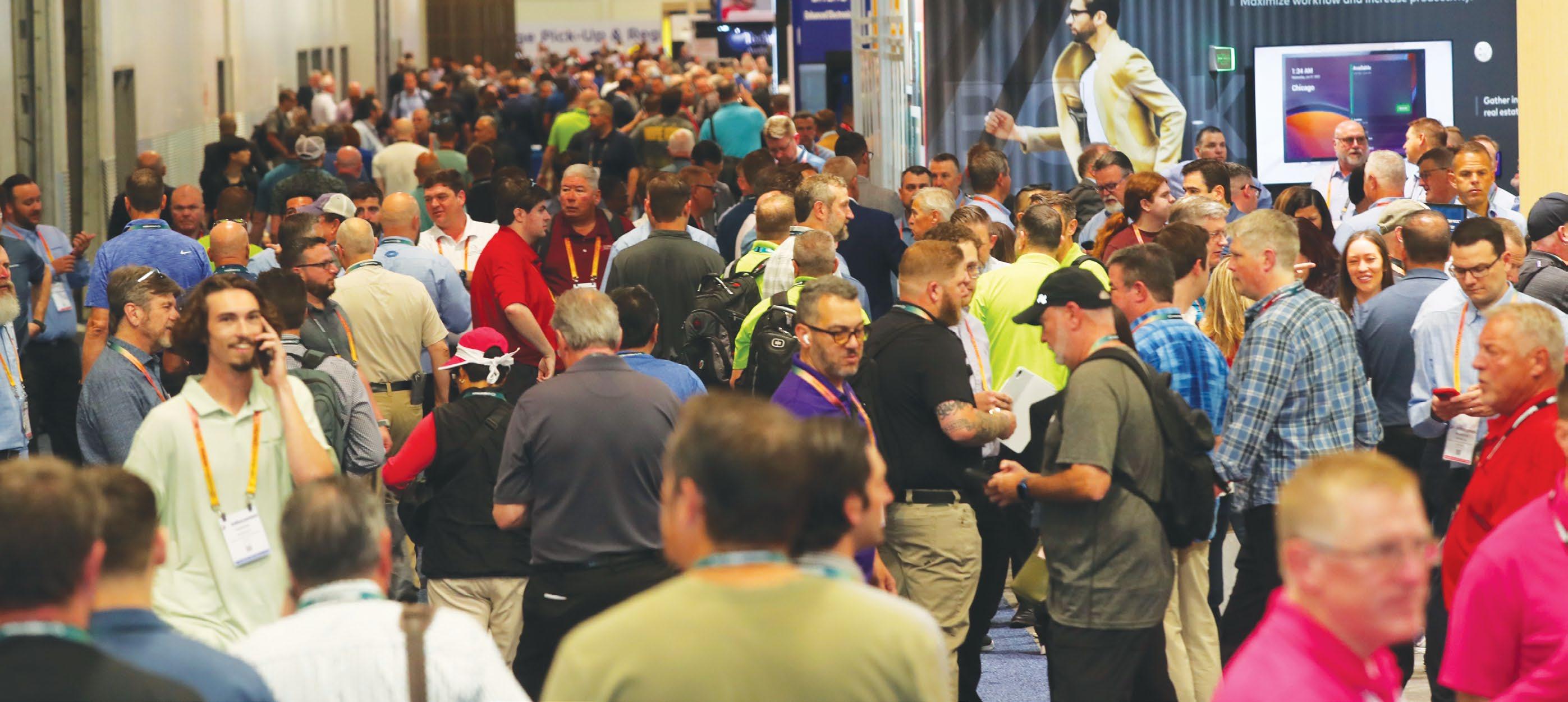
By Wayne Cavadi
InfoComm 2025 is set to return to Orlando this month. As we have in the past, SCN turned to several exhibitors and asked: What buzzwords do you expect to be the talk of InfoComm 2025?

Duncan Miller, Director of Global Marketing, Adder Technology
Discussions around the impact of AI continue to be at the top of the list, although time will tell how AI will add reliable value in AV workflows. However, when we talk to customers at InfoComm, we continue to hear conversations about security, remote access to virtualized environments, and multiviewer capabilities. This year, we know API and system integration into existing workflows will be a hot topic, and we’ll have some exciting API updates to demonstrate on our booth.

Thomas Tang, Founder and President, Apantac
Several key buzzwords are expected to shape the conversation across the show floor. AV over IP will be a central theme, with formats such as IPMX, SDVoE, and NDI driving discussions around interoperability, low latency, and efficient network-based distribution. Hybrid work and remote collaboration will remain in focus, emphasizing KVM over IP, BYOD integration, and unified communications platforms, particularly for control rooms and command centers.
AI-driven AV technologies—including intelligent audio mixing, auto-tracking, and video analytics— are gaining traction, while sustainability continues to
influence product development through energyefficient, modular, and future-ready hardware designs. Edge processing will also be prominent, with compact, fanless devices enabling real-time AV workflows at the edge. Additionally, immersive experiences for museums, retail environments, and extended reality (XR) applications are expected to draw significant attention.

Mark Donovan, Director of Commercial Applications, Audio-Technica
AVIXA’s emphasis on educational applications aligns closely with the trends we’ve been observing. Both higher education and K–12 institutions have experienced sustained growth in recent years, even after the height of the COVID pandemic. The benefits of remote learning and touch-free operation extend well beyond health-related concerns, making these technologies valuable long-term solutions. As a result, educational facilities are continuing to adopt and invest in these approaches.

Paul Harris, CEO/CTO, Aurora Multimedia
AI seems to be the main buzzword, and Aurora will be showing a few solutions taking advantage of this technology. We already introduced the first-ever control system tool using AI, and we have even more to open people’s eyes and change the AV industry forever.

Bob Caniglia, Director of Sales Operations for the Americas, Blackmagic Design AV over IP continues to gain momentum as the industry shifts from
traditional AV distribution to network-based solutions. Blackmagic Design is expanding its AV over IP offerings, focusing on SMPTE ST 2110 standards to facilitate seamless integration of traditional SDI equipment into modern IP-based infrastructures. Additionally, immersive video and immersive AV have emerged as compelling new ways to engage audiences, going beyond traditional flat-screen video and stereo audio to create a heightened sense of presence and realism for the end user. With applications in live performance, education, virtual tourism, training, museums, and more, immersive AV blends physical and digital elements to support more realistic storytelling.

Ryan Prentice, President, Cleerline
AI supporting smart automation, control, and content creation; security and IT convergence enabling more cybersecurity for AV hardware/software; sourcing shifts and alternatives due to tariff issues; and future proof. Looking forward, we know that bandwidth demands will increase each year, and fiber is a key component, ensuring that integrators can offer the newest solutions to clients.

Lisa Barlow Flournoy, Marketing Support Manager, DVIGear
Tariffs. Current foreign trade policies will be the elephant in the room unless there is substantial effort taken to restabilize. It will be hard to ignore both short and long-term effects that profound changes in global trade will have in our market. [Another is] innovation. Significant challenges may become grist to the mill, producing creative solutions in all sectors of the AV industry.

Theresa Benson, VP
of Marketing & Product Management, Mersive Technologies
Expect to hear a lot about interoperability, AI-driven “X,” and flexible. But we know the real value lies behind the buzz—solutions that are intuitive to use, easy to manage, and built to evolve with customer needs.
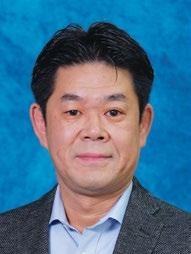
Taka Uchida, CEO, Panasonic Projector and Display
Americas
AI and cloud-based solutions are sure to be a key focus this year, as streamlining workflows remains top of mind for the industry. Automation, such as our cloud-based device management capabilities, and seamless integration will be at the center of this transformation. From a visual experience perspective, the power of immersive and the impact of 4K visuals are sure to be top of mind. As organizations look to create engaging immersive experiences, they need those visuals to be high-quality and realistic. That’s where 4K projection technology becomes critical.

Joyce
Bente,
President/CEO Americas, Riedel Communications
At InfoComm, expect to hear a lot about AI, but also key buzzwords like efficiency, AV over IP, 5G, all-in-one solutions, and plug-and-play technologies. The focus will also be on smart devices, networked AV, low-latency, cloud-based control, edge devices, and interoperability—all driving the future of seamless, scalable AV integration.

Sean Bowman, AVP of Sales North America, Shure
We expect to have many conversations about how AI is shaping the future of the AV industry. It’s not just a buzzword; AI continues to be a transformative tool Shure has been incorporating into our technology for years, with the goal of maximizing collaborative experiences. We hear from customers that they want top-tier performance, reliability, and management for their facilities with less complexity. This brings us to another keyword for Shure this year—Zero Touch Provisioning—which
means simplicity at the point of installation. With our IntelliMix Room Kits, everything autoconfigures directly out of the box. This streamlined installation is key to expediting and improving the overall customer experience.
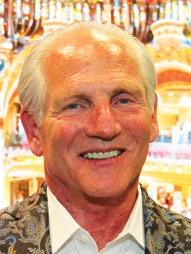
Michael Wiener, CEO and Founder, Vanguard LED Displays
The potential terrible impact of tariffs on our industry. Vanguard’s main focus at this year’s show will be discussing the tariff situation. Should the tariff issue be miraculously resolved before the show, our main focus will be our Infinity controllers.

Nick Mathis, Director of Business Development, North America, VuWall AI will certainly dominate conversations, alongside “country of origin” concerns like tariffs and trade compliance. We also expect to hear a lot about standardization— especially as the industry pushes for more unified protocols across AV systems.

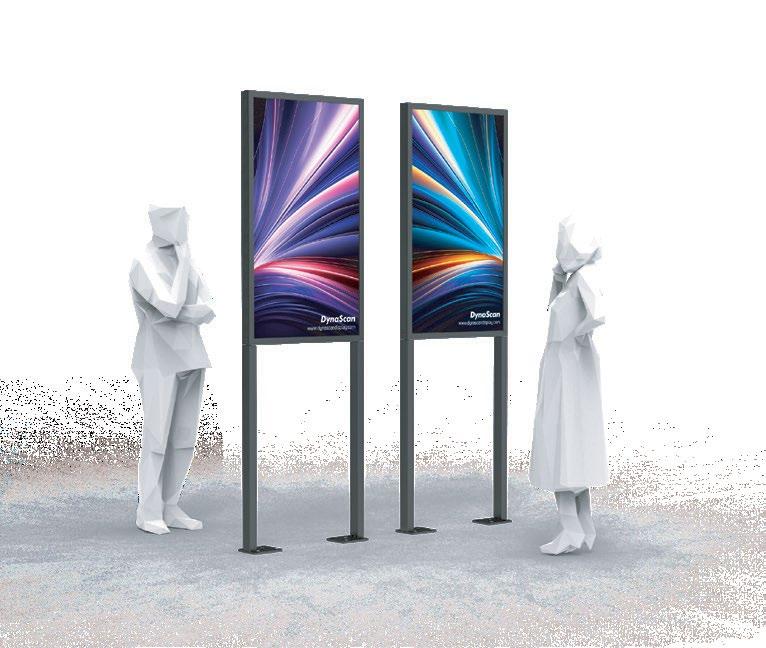

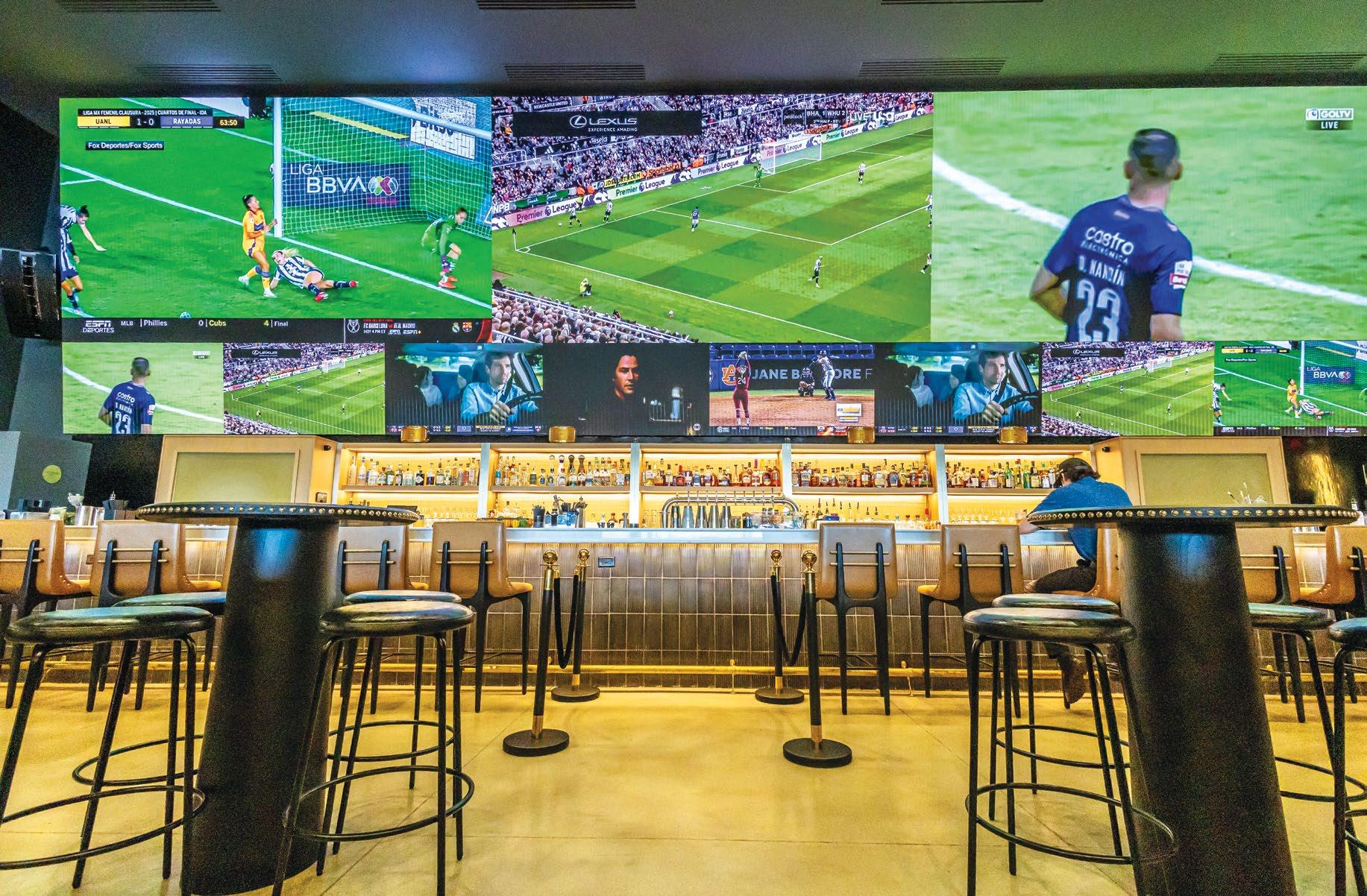
By James Careless
There was a time when the term “restaurant AV” meant an analog TV set sitting on the bar and a reel-to-reel tape deck playing Muzak. No longer: In the 21st century, restaurant AV means taking video and audio to the next level and beyond, because today’s tech-savvy patrons expect no less.
The Big, Big, Big Picture
There are large displays in sports bars across the United States, and then there’s the gigantic 4K display in Blinders Sports Lounge in Charlotte, NC. This 5,500-square-foot sports bar/restaurant, which seats 160 inside and 60 more on the 1,500-square-foot patio, has installed an 850-square-foot 4K dvLED video wall over its bar.
Visible from all areas of the main room, the 10,000-pound display can show up to 24 different feeds or any combination of fewer feeds at a larger scale for sports, parties, movies, and esports tournaments. It’s no wonder that Blinders describes the visual experience as immersive viewing: It’s like having a video billboard inside the sports bar.
“Kush Anandani, the owner of Blinders Sports Lounge, is an avid sports fan who wanted to create an incredible space in his hometown of Charlotte that mimicked the exceptional experiences he had watching sports at different Las Vegas spots,” explained Rob Meiner, technical sales engineer for Peerless-AV, which provided the mounting system for the video wall in association with AV design firm DCBolt Productions.
“To achieve this, Kush wanted to provide a highdefinition viewing experience of a sportsbook, combined with the live energy of a sports lounge and the luxurious detailing of a cocktail lounge.”
Of course, offering a gigantic video wall isn’t enough. To motivate sports fans to come back to Blinders after watching the game here once, the viewing experience has to be as comfortable as possible. “The Unilumin USlim2 displays are mounted at a 10-degree forward tilt, making this structure stand out as unique as it delivers the ultimate viewing experience for every guest, no matter where they are seated,” Meiner said. “We implemented a SEAMLESS Bespoke floor-to-wall mounting structure made of steel, weighing 6,000 pounds.”
The video wall is controlled by an iPad loaded with the Creston Go app, so it can support custom software made by DCBolt. The lounge is also home to a nearly 50,000-watt VOID Acoustics sound system, also installed by DCBolt, that feeds a row of 24-karat gold-plated speakers installed under the dvLED screen. Total cost for the AV package: a cool $1.5 million.
Currently being billed as the largest dvLED video wall of its kind on the East Coast, the installation required a great degree of care and forethought. “For a dvLED video wall of this scale, precision engineering is critical to account for factors such as total wall load, tight tolerances, and heat dissipation,” said Meiner. “To guarantee optimal performance for 24/7 operation, we conducted thorough testing on samples in advance.”
Sunlight and indoor lighting had to be factored into the mix as well. No problem: “Besides having the angle of the video wall tilted forward 10 degrees,
Blinders and their industrial designers selected fixtures that are appropriate for the space and ensured they were placed and angled correctly,” Meiner noted. “This includes ceiling lights and wall sconces that have baffles to direct light and prevent it from spilling. Additionally, windows are slightly tinted to filter outdoor lighting to create a darker ambiance, while the indoor lights are considered warm white light.”
Then there was the challenge of fitting the video wall into the restaurant itself. “Some of the challenges included fitting large-scale installation equipment within the space, such as getting an atrium lift inside the building, and the structure of the bar making it impossible to use ladders or scissor lifts,” said Meiner. “Additionally, working with several types of teams at once in such a tight space and limited time frame presented its challenges, but through collaboration and constant communication, we ultimately made it work to achieve the desired results.”
The Blinders video wall and VOID sound system were installed and ready to go in time for March Madness earlier this year. “Everyone is extremely happy with the final result,” Meiner concluded. “Peerless-AV’s close partnership with DCBolt throughout the installation allowed the teams to navigate tight timescales to deliver a result that lives up to its promise of exhilarating, immersive 4K sports action from the moment guests step inside.”
Prati Italia is an upscale Italian restaurant in Jacksonville, FL, whose many rooms are also used for private events and conferences. The sound system at this restaurant was modern when it was installed in January 2013. But time and technology wait for no one, which is why Prati Italia decided to upgrade its audio



system as its existing equipment started to fail.
As it turned out, its best choice was to install a SoundTube DSM-16 Dante system manager, which transported audio using Prati Italia’s existing network cables and outlets. This proved to be an ideal solution for this location.
“The old audio system had equipment in various rooms with separate control panels,” explained Ken Hecht, VP of SoundTube Entertainment. “Integrating it through the centralized Ethernet network enabled us to use existing Ethernet cables, which simplified the installation. By using PoE to power the new amplifiers, we were able to centralize everything in one location and add new capabilities without the expense and time required to run cabling.”
Prati Italia IT manager Jerry Gray chose a costsaving hybrid approach for the upgrade, an approach that allowed the restaurant’s legacy Crown and Ashley amplifiers to be integrated with the DSM-16 and three SoundTube IPD-Hub 2 DSP amplifiers on a propertywide network. The DSM-16’s audio outputs, which can be assigned to different areas of the restaurant on a zone basis, are sent to various SoundTube speakers.
The restaurant has 18 RS500i pendant speakers and 23 CM62-BGM 6-inch in-ceiling speakers in the interior areas. Meanwhile, the outdoor deck has 10 SoundTube SM82 8-inch outdoor extreme weather surface mount speakers, plus four amplifiers designed for multi-room applications powering passive speakers, an audio extender box, and a
remote volume control system.
The best part: “All of the audio zones can be controlled using a tablet computer,” said Gray. “So, not only is our new sound system more flexible and better sounding than ever before, but it is extremely easy to control from anywhere in the restaurant using a tablet.”
Obviously, the AV installations at Blinders Sport Lounge and Prati Italia are very different. Still, some common lessons can be learned from them both. For one thing, there are innovative restaurateurs who are open to investing in the latest AV technology, which means there are opportunities worth exploring by integrators and installers.
Also, the advanced possibilities offered by modern AV equipment can make a real difference in making restaurants more attractive to patrons. In a very obvious sense, the gigantic video wall at Blinders gives sports fans a good reason to keep coming back. In a more subtle way, the same can be said of Prati Italia’s audio system, which helps make the dining experience more enjoyable. Restaurant AV can be expensive and eye-catching or affordable and enhancing—but either way, it can be a competitive advantage that can help keep patrons coming back for seconds.
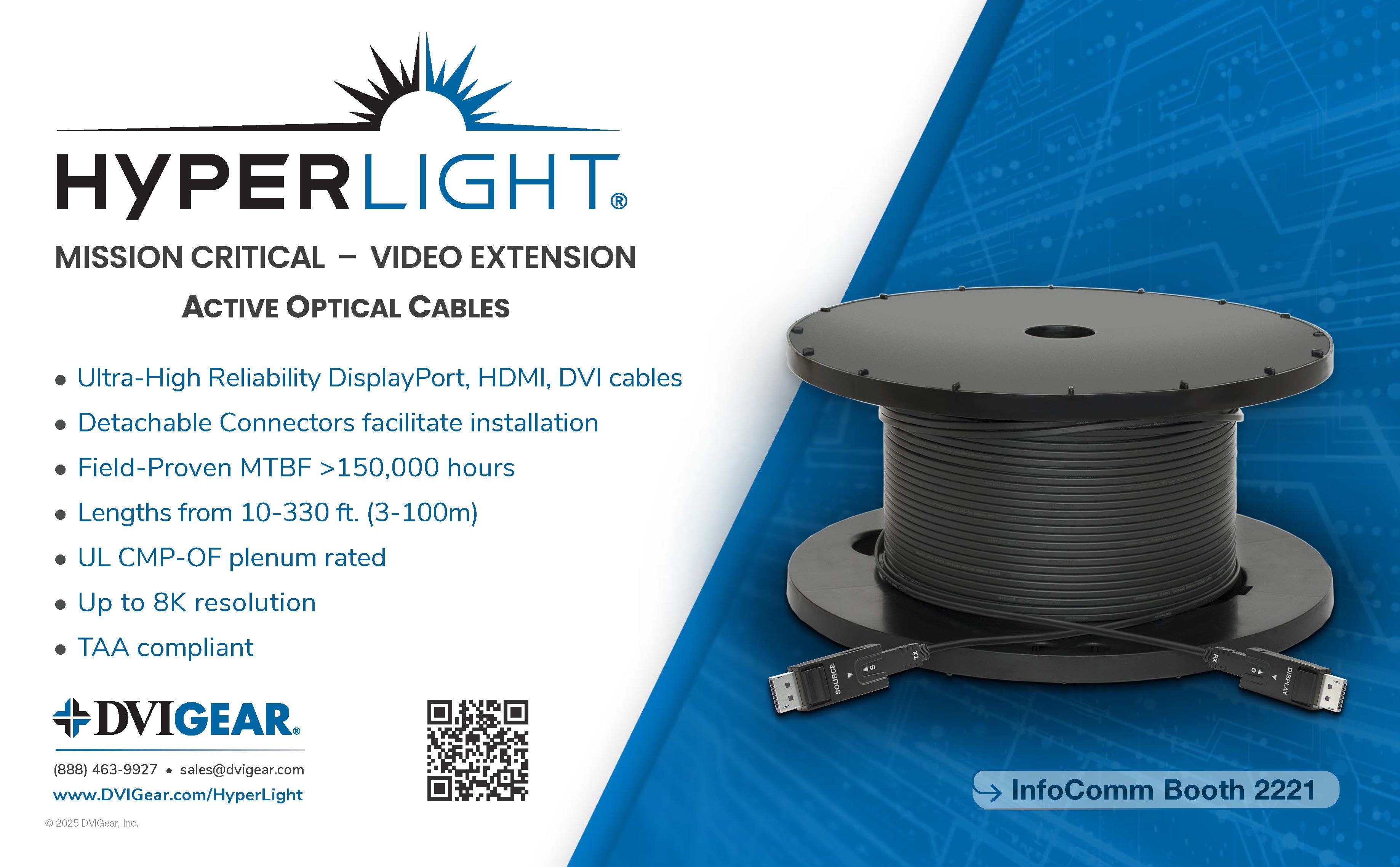
Maury County Judicial Center Embraces Benefits of Courtroom AV
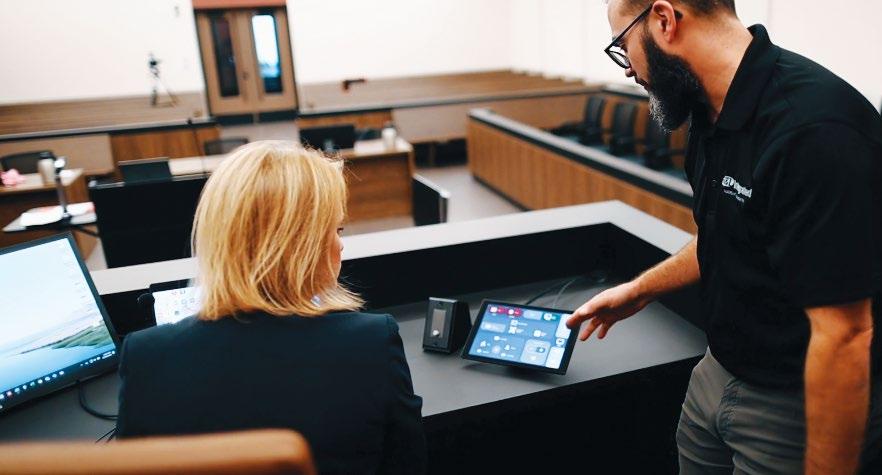
Part of the AV package that S&L Integrated proposes to its courthouse clients includes a combination of Audix conferencing microphones, such as the MG18 and MG18HC gooseneck condenser mics mounted in the ATS1 tabletop base, as well as ADX60 boundary mics to capture speech from those who aren’t equipped with a dedicated microphone.
“From an audio perspective, the most important person in the room is the witness,” said Gage Helton, director of operations at S&L Integrated. “The second most important is the judge. Then, obviously, you need to be able to hear the jury. Many contractors that do general purpose installations don’t make things audible enough when they do courtrooms, or there’s feedback because they didn’t EQ the room. For this reason, we tend to use column array speakers, tune them, then the MG18 mics in most places. But for positions closer to the arrays, we’ll opt for the MG18HC, which is essentially the same mic with a hypercardioid pickup pattern.”
Witness and jury foreman mics are usually shock-mounted, with everything else mounted on the ATS1 bases. The ADX60s are placed on prosecution and defense attorneys’ tables to capture sidebar discussions.
Helton noted that the ATS1 base’s physical button is easier for nontechnical operators to use, versus bases that incorporate either a touchscreen or capacitive button. “We’ve found that users can get confused by those— especially when you factor in the stress that comes with being in court—and either fail to trigger them when it’s their turn to speak or accidentally turn them on when it’s not,” he explained.
The unit’s detachable cable also makes for smoother installs. “A lot of gooseneck bases for conferencing have an attached cable, so you need to
By Carolyn Heinze
Completed in Fall 2024, the Maury County Judicial Center in Columbia, TN, is a newly constructed, 58,000-square-foot facility designed to accommodate a growing region while modernizing court proceedings at the same time. Nashville, TN-based architect Workshop oversaw planning and building design, while S&L Integrated, headquartered in Thomasville, GA, deployed the courtroom AV systems.
A two-story building, the new courthouse houses six courtrooms, three on each floor. Upstairs, one jury courtroom features a traditional layout, with the jury box to the side of the bench and attorney tables. The other two incorporate the Virginia Revival Model (VRM), which puts the jury in front of the judge’s bench. Four associated enclosed spaces are assigned to each courtroom, providing attorneys and their clients with somewhere to meet privately.
For architect Workshop, one design goal was to incorporate elements referencing Maury County’s historic courthouse building a few blocks away in Columbia’s downtown core. For example, the pews positioned throughout the public hallways were extracted from the historic building and refurbished for the Judicial Center. The thin film coverings on the

figure out how to dress it and route it in an unobtrusive way. With the ATS1, we can just run our own cable and terminate, which makes the install so much cleaner,” he said.
While this may seem like a lot of microphones, there is a need to take all courtroom participants into account. “One reason is, in many installs we send multitrack audio to the court reporter so they can produce the most accurate transcript possible,” Helton said. “Another is that we like to have a press feed plate for higher-profile cases, so reporters can just plug in and get a clean audio mix. For larger courtrooms, we’ll also do a mix-minus through small speakers at various locations, so the participants can hear everyone else clearly but not have echo of themselves.”
private conference room windows, featuring images depicting Maury County’s history, are another element.
“Recognizing that they were moving from the historic courthouse was very important to them,” James Kennon, principal architect at architect Workshop, explained in a video produced by S&L Integrated. “We worked with the county archives to develop a series of photos that told the history of the county.”
From a technological perspective, Maury County needed courtroom AV systems that could support digital evidence such as body and dashcam footage as well as surveillance videos, explained Stan Mobley, senior account executive for state, local, and corporate clients at S&L Integrated. This need is prevalent among the courthouses his firm works with in Georgia and Tennessee, as is the integration of reliable videoconferencing capabilities and user-friendly control.
To address this, S&L Integrated developed a courtroom AV package that can be tailored to meet specific client requirements. In general, it includes Crestron DM NVX AV over IP distribution, Q-SYS control, QSC ceiling speakers, Marshall POV cameras, LG displays, a combination of Audix microphones and Sennheiser wireless systems, and WolfVision whiteboard and annotation tools (when requested).
this promotes standardization across courthouses, which facilitates service and support for the AV integrator. Perhaps more importantly, it provides a smoother user experience.
“Within a circuit, there may be three judges and six courts,” Mobley added. “The courtrooms may look
different—some may be modern while others are historic. But when we standardize the systems, a judge coming from County A to County C doesn’t have to spend time learning a system that’s unfamiliar to him. He has a touchpanel that looks exactly like the one in his home court.”


At the Maury County Judicial Center, the primary goal was to provide a good user experience for everyone working in the courtroom, including the judge, attorneys, court clerk, court reporter, and other staff. To achieve this, it’s necessary to understand how each judge runs his or her courtroom, explained Nathan Tomberlin, account executive at S&L Integrated. For example, do they want the ability to approve digital evidence before attorneys share it wirelessly to courtroom displays? If so, their touchpanel must be equipped with “preview” and “approve” commands.
“This is putting protections in place to follow the due process of how the judge wants to manage the court proceeding,” Tomberlin said. “It puts all of the power back on the judge.”
It can also allow for flexibility. During particularly intense proceedings, a judge may give the court clerk authorization to run the technology from their own touchpanel, so the judge can keep their focus on witness testimony. Good control programming can also simplify things for the court reporter, who may access and modify mic volumes through their touchscreen.
“They don’t have to go through their software with their mouse to click on the microphone levels to get them right,” Tomberlin said. “Instead, we give them a touchpanel and they can make any adjustments right there on the screen.”
While each courthouse is different, they all share common requirements, which is why S&L Integrated offers a courtroom AV package. As Mobley explained,




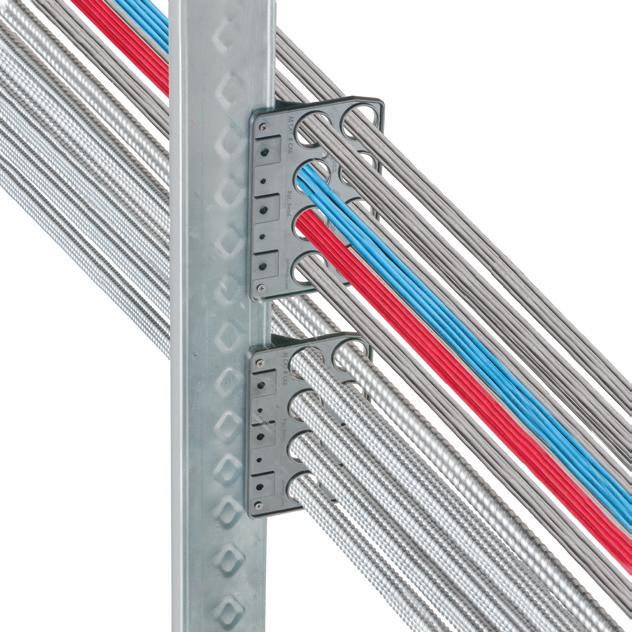


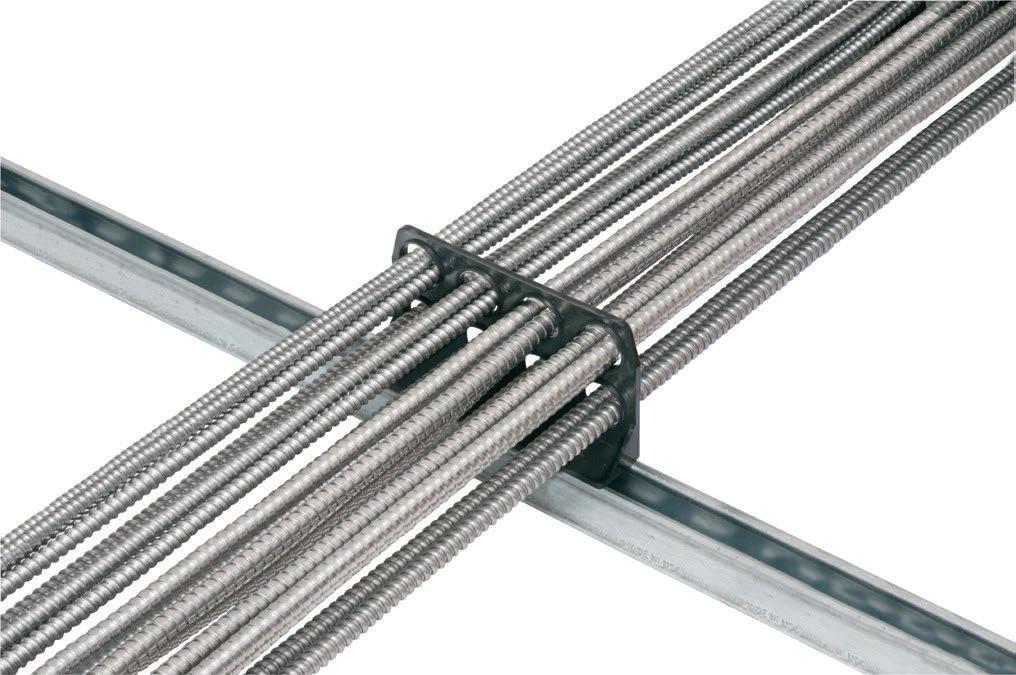
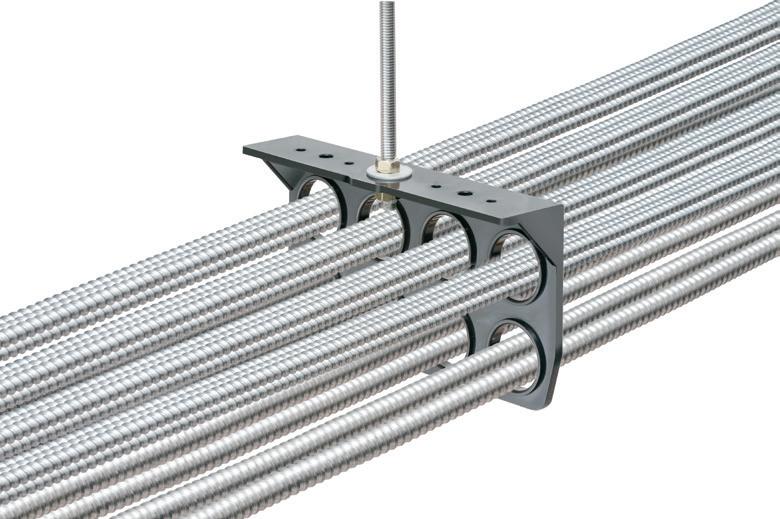

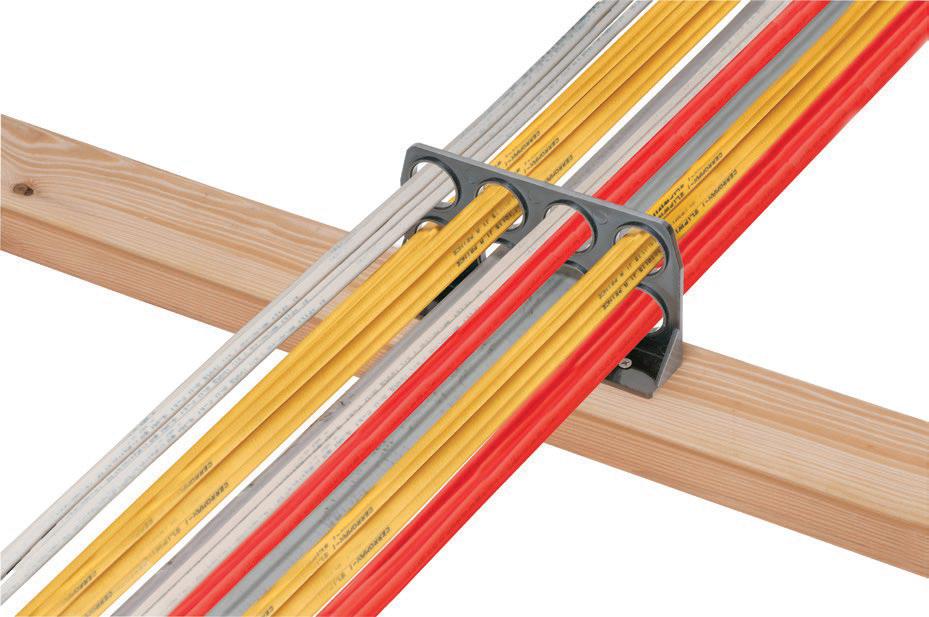





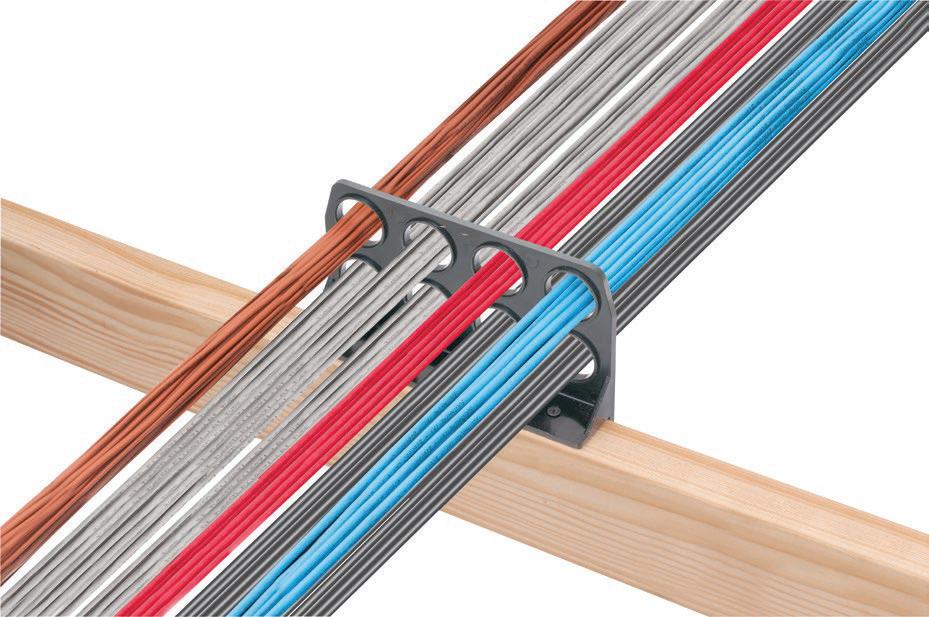
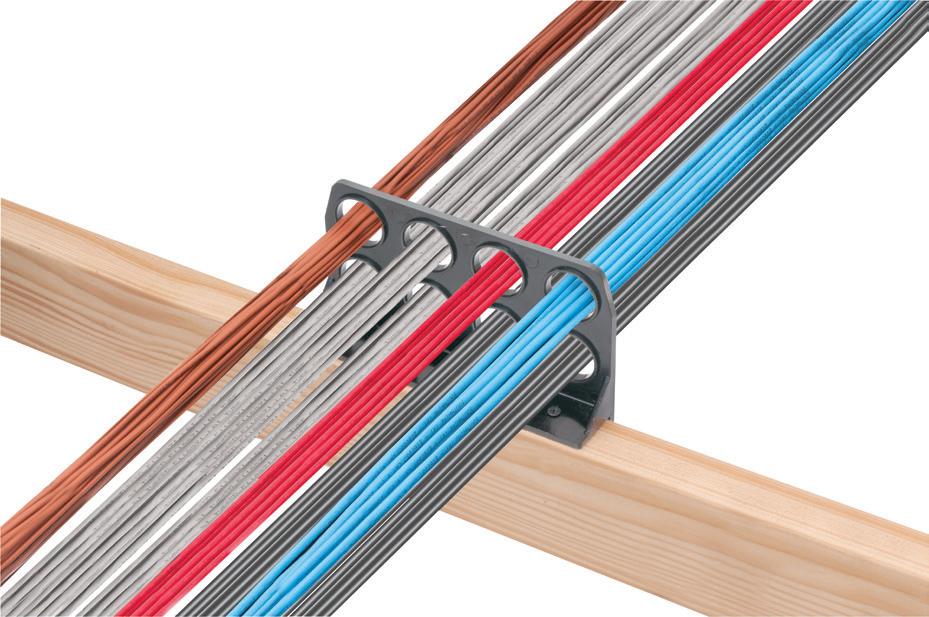
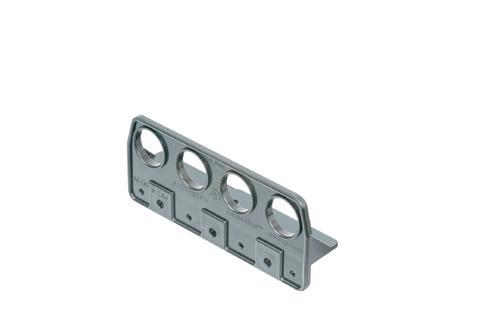
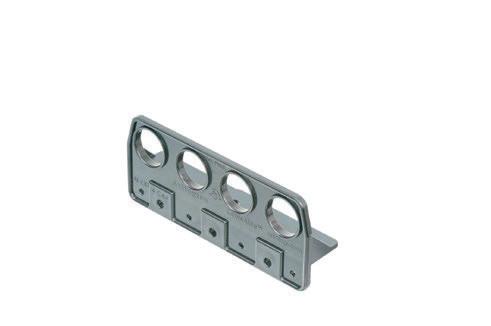




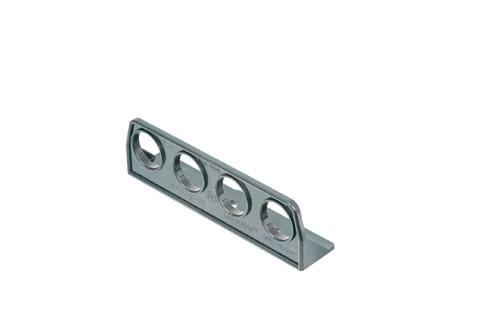
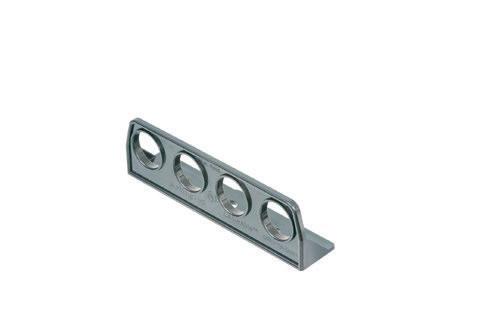
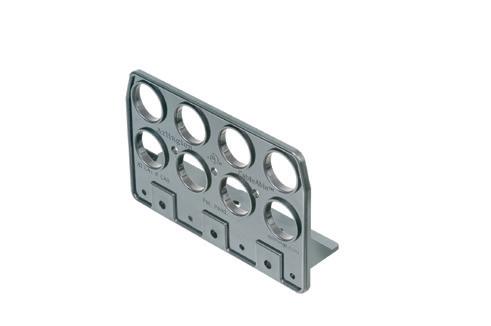


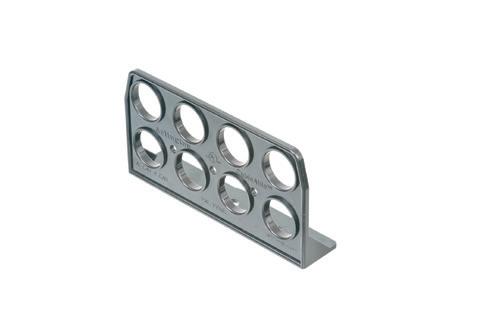
By Wayne Cavadi
Plainfield High School, located in Plainfield, NJ, recently underwent a major renovation on its campus. The project included the upgrade of the existing Plainfield High School auditorium to a professional-style performing arts center, its minitheater converted to a black box theater, and two classrooms transformed into a new esports arena.
It was no easy task. One focus of the renovation was on making the auditorium the main viewing space for esports events. The problem? The performing arts center and theater were adjacent to each other; however, the esports arena was on the other side of the school. PureTek Group was brought on to make the vision and future of esports at the high school a reality.
Considering the magnitude of the project—three unique spaces that had to be interconnected despite the space between—PureTek Group completed the renovations quickly; it was only a year and a half from inception to the ribbon cutting on June 7, 2024. According to Dan Litvin, president, PureTek Group, the primary challenges were threefold.
For one, Litvin and his team needed to create a cohesive and integrated system across three distinct yet interconnected venues, each of which incorporated innovative technologies tailored to its unique function. Ensuring these systems worked harmoniously required meticulous planning and a deep understanding of both the individual requirements of each space and how they could complement one another.
That required forward-thinking, enhanced technologies leading to a second challenge—it had to be usable by the school staff and students operating the venues. “Designing high-performance systems is only part of the equation,” Litvin added. “Ensuring they are accessible, intuitive, and support a wide range of programming and curriculum needs was essential.”
Another major challenge was to future-proof the design, ensuring the venues remain visually inspiring, technologically advanced, and educationally relevant for years to come. “This meant not just using the best available technology but also designing with adaptability and evolution in mind,” Litvin said.
Of course, there was also the challenge of tying it all together and keeping the communications open from the control room to the spaced-out theaters and arena. With the auditorium and esports arena on different sides of the school, a reliable intercom system that ensured good range and coverage was

non-negotiable.
Litvin and PureTek Group selected Pliant’s CrewCom 2+2 Control Unit (CCU) for the auditorium control booth, with three CrewCom 900MHz Radio Transceivers (RTs) located throughout the school to provide seamless coverage. The system also includes seven CrewCom 900MHz 2-Volume/2-Conference Radio Packs with seven SmartBoom PRO single-ear headsets.
“The main benefit that we found with this system is that the radio packs can ‘roam’ or switch between different radio transceivers for optimal signal quality, while maintaining uninterrupted communication,” Litvin detailed. “This gives the user the ability to be within any part of the larger coverage area and still have connection.”
This was important for this project because the CrewCom system is used during performances to coordinate between the control booth, backstage, and sometimes the green room (either the black box theater or a repurposed classroom during events). Also, during esports tournaments, while the auditorium is used as a viewing area for the live gameplay, the main
broadcast setup is in the esports arena.
“The Pliant system allows the school to coordinate between the auditorium control booth and the broadcast setup in the esports arena,” Litvin explained. “This allows for clear instructions among the entire production team and provides a cohesive, professional, and incredibly memorable experience for the audience.”
It was the collaboration between Plainfield High School, PureTek Group, and expert partners that got the job done so successfully. “We maintained open and consistent communication, proactively solved issues before they became problems, and stayed focused on delivering a world-class result that reflects the values and vision of the Plainfield community,” Litvin said.
Plainfield Public Schools’ leadership wanted to give its students every advantage and to make their new esports arena a must-see site for competitions. What started as a small, summer initiative caught fire and required its own arena for competitions.
Viewing the competitions takes place in the 1,600-seat performing arts center. Per Litvin, spectators can watch on a new 35x14.8-foot Da-Lite screen, which is supported by a Barco UDM-4K30 projector with R9862020 lens, as the event is streamed in real time with immersive lighting in the auditorium reflecting the effects in the esports arena to engage attendees. Live sounds of the audience are captured and played over speakers in the esports arena to keep players engaged with the attendees.
Because the black box theater across campus serves as a green room for esports events, clear and concise communication between the production

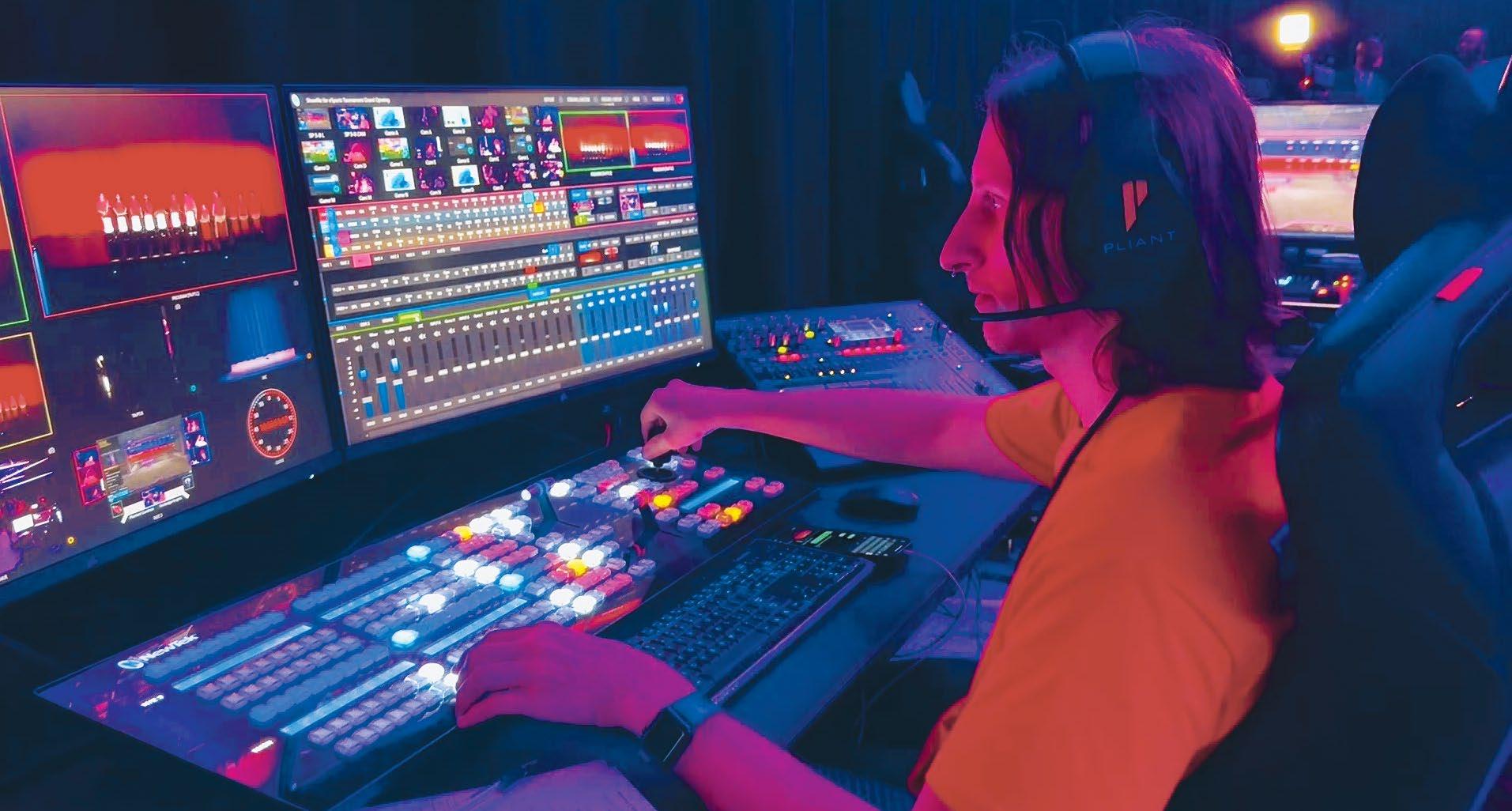
teams is a must. “To achieve a collaborative performance, communication is key, so reliable coverage from a distance is a necessity,” Litvin explained. “With CrewCom, production personnel at the school are able to communicate clearly from the esports arena all the way to the backstage booth in the auditorium. The CrewCom system is used extensively throughout the school and produces unified performance, from standard backstage theatrical production applications, to managing cameras, lighting, and audio from room to room at a distance.”
The arena itself—which is restricted to competitors, coaches, and production teams—has 20 gaming stations that accommodate four teams of five players, with additional stations that are home to broadcast operators, two sets of shoutcasters, and a replay operator. It is also used for esports practices and hands-on STEM opportunities, making it much more than a gameday production center.
As Litvin explained, Corsair/Origin gaming machines were selected for the stations, while 20 PTZOptics Studio Pro cameras were chosen to capture players’ emotions and responses in real time. Two PTZ cameras capture wide views of the arena, two additional cameras capture shoutcaster teams, and a feed from the replay operator highlighting top plays in real time are used to livestream on YouTube, Twitch, and the auditorium. Productions are managed with a Vizrt TriCaster 2 Elite video production system.
The auditorium was not a fresh build but a renovation, which certainly helped the timeline. According to Litvin, prior to the upgrade, the auditorium contained outdated and broken technology, a difficult-to-use control system, and an uninviting aesthetic. Litvin and PureTek Group enhanced that with professional grade technology, making the performing arts center not only an exciting venue for cheering on the Plainfield esports team, but a wide range of theatrical performances for years to come.
As Litvin described, key to the upgrade were the unRAVL Controls by PureTek, which provide
streamlined intuitive controls via touchpanel for the rigging, AV, and lighting systems to maximize usage of the space by students, educators, guests, and renters with authorized system access. A 30,000lumen 4K laser projector brings the 35x14.8-foot projection screen to life. The screen is on a motorized hoist system to be raised and lowered for usage. A line-array speaker system, including Electro-Voice and Dynacord units, flanks the stage, while fill speakers below and above the balcony ensure even and high-quality sound distribution.
Additionally, the performing arts center contains more than 1,640 feet of RGBW strip lighting by Acolyte (with controls by Madrix) on 11 runs that cover the walls and ceiling. PureTek Group lighting designers outfitted Plainfield High School with control of 4-inch increments of the strips, with various presets. Also installed were three 4K PTZ cameras and one portable handheld camera to livestream performances to the Plainfield Public School’s YouTube channel.
“Students and parents can receive recordings and share, in real time, with relatives and friends from near and afar,” Litvin said.
According to Litvin, the 120-seat black box theater was an underutilized, existing space that wasn’t properly outfitted for performances. Now it is serving multiple purposes.
“As an esports green room, athletes will be able to watch gameplay in the black box theater while they await their scheduled
game time,” Litvin explained. “The [theater] is also being used as a setting for drama education, theater tech practice, as well as a small intimate setting for student-run productions. It is also being utilized for professional education seminars for Plainfield Public Schools educators and administrators, while also providing a college lecture-hall style classroom setting to prepare students for university and provide an alternative setting for education.”
To accomplish the multifaceted happenings in the theater, it was equipped with a comprehensive unRAVL system including new rigging, AV, and lighting. The system is tied together via intuitive controls with presets for common applications, allowing usage of the space for multiple functions by a maximum number of users.
Plainfield High School and PureTek saw immediate positive results, right from the start. “During the ribbon cutting, the Pliant CrewCom intercom system was a lifesaver,” Litvin said. “We had clear communication between the esports broadcasting space, the main control booth in the auditorium, and with students running production backstage. It allowed students to take ownership as well as enabled the smooth running of a complex event that included many back-to-back performances.”
The key to communications has been its ease of use, and that has shined through the early stages of use. “Making sure that students are able to use the equipment and that the controls are streamlined enough for them is always a consideration in our equipment selection,” Litvin concluded. “The feedback from Plainfield High School on the Pliant gear has been great.”


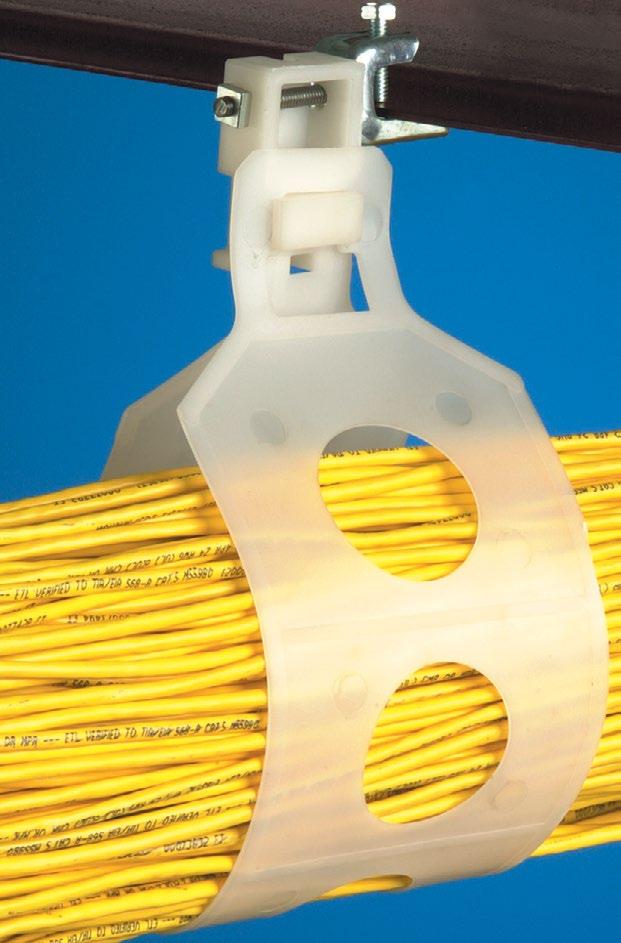


By George Walter
nitially co-developed between Texas Instruments and Digital Projection, Digital Light Processing (DLP) technology has been around for more than 25 years. What started as a revolutionary technology designed to bring digital video to commercial movie theaters has evolved into one of the most widely adopted technologies across multiple applications. Today, DLP is a dominant force in corporate, educational, and home theater markets, delivering highquality visuals with precision and brightness.
When DLP projectors were first introduced, they were based on a three-chip design. Each of the three chips was dedicated to one of the primary colors: red, green, and blue. These chips worked in conjunction, converging their outputs to produce a full-color image that was projected onto a screen using a high-powered lens system. This three-chip configuration was a game-changer in digital projection technology, delivering a new level of image quality and color accuracy.
Not long after the introduction of three-chip DLP projectors, single-chip DLP projectors emerged as a viable alternative. This advancement was possible due to the fast switching speed of DLP micromirrors. Instead of using separate chips for each color, single-chip DLP projectors sequentially displayed red, green, and blue images using a single digital micromirror device (DMD). This innovation made projectors significantly smaller, lighter, and more cost-effective while maintaining high levels of brightness and efficiency.
One key factor that sets DLP apart from other projection technologies is its truly “digital” nature. Unlike Liquid Crystal Display (LCD) and Liquid
Crystal on Silicon (LCOS) projectors, which rely on analog voltage modulation to control each pixel, DLP technology operates using binary digital light processing. Each micromirror on a DMD chip has only two positions, on or off, a binary approach that provides several advantages.
One key factor that sets DLP apart from other projection technologies is its truly “digital” nature.
• Uniform image reproduction. Because each micromirror functions in an identical manner, DLP ensures consistent brightness and uniform color reproduction across the entire image. In contrast, LCD and LCOS projectors, which depend on varying voltage levels to control pixels, may suffer from slight voltage inconsistencies that cause non-uniformity or blotchy images.
• Higher native contrast ratio. The ability of DLP mirrors to tilt at extreme angles results in deeper blacks and higher contrast ratios, making it an excellent choice for home theater enthusiasts and professional applications requiring superior image quality.
• Faster response time. The rapid switching speed of DLP micromirrors minimizes motion blur, making it particularly well-suited for fastpaced video content such as sports, gaming, and action-packed movies.
Over the past 25 years, DLP technology has undergone continuous refinement. One of the early challenges of DLP projection was the visibility of a “dimple” in the center of each pixel, caused by the mechanical structure of the micromirrors. Through design improvements, these dimples were minimized and eventually eliminated, resulting in increased efficiency, greater brightness, and improved contrast ratios.
Another significant advancement has been in the pixel density of DLP chips. As demand for higher resolutions has increased, DLP technology has kept pace, evolving from SD to Full HD and now to 4K resolutions.
RGB pure Laser: The New Revolution Improvements in color wheel technology have further elevated DLP performance. Initially, color wheels consisted of only three segments: red, green, and blue. While effective, this setup caused a “rainbow effect,” characterized by a noticeable separation of colors and artifacts in the projected image. To mitigate this issue and enhance color reproduction, manufacturers incorporated additional colors such as cyan, magenta, and yellow to the color wheel. This also resulted in brighter imaging.
One of the most significant innovations in DLP projection was the ability to create 4K images using a 2K modulator. Initially, skeptics dismissed this as “faux-K” rather than true 4K. However, DLP’s ability to rapidly switch micromirrors—at speeds of 20 millionths of a second— allowed it to create four distinct pixels from a single micromirror. This was achieved through an optical shifting technique known as a “wobulator.”
When tested against traditional 4K projectors, text patterns and fine details confirmed that DLP was fully capable of resolving all pixels of a 4K
image. This innovation made 4K projection more accessible and cost-effective, further solidifying DLP’s position in the market.
As technology advances, the latest evolution in DLP projection is the introduction of RGB pure laser technology in combination with single-chip DLP projectors. Traditional lamp-based projectors require color wheels or phosphor-based light sources to generate colors. While effective, these methods introduced certain limitations, such as potential color separation artifacts and mechanical noise.
With RGB pure laser projection, individual red, green, and blue lasers are used as direct light sources. As a result, RGB lasers produce more vivid, true-tolife colors, achieving nearly 100% of the Rec. 2020 color gamut—the widest color space available in consumer displays. Lasers have a much longer lifespan compared to traditional projection lamps, reducing maintenance costs and enhancing durability.
Without a spinning color wheel or high-wattage lamp, RGB laser projectors generate less heat and operate more quietly, making them ideal for home theaters and professional environments. And because RGB lasers don’t rely on color wheels, the risk of color separation artifacts is completely removed. That means no more rainbows.
Over the past 25 years, DLP technology has undergone remarkable advancements, making it one of the most versatile and widely adopted projection technologies available today. Looking ahead, we can expect even greater innovation. For example, as consumer demand for ultra-highresolution content grows, we may see even more refined implementations of 8K and beyond.
Potentially, DLP could be integrated with emerging display technologies like microLED to enhance brightness and contrast. AI-enhanced image processing, based on advanced machine learning algorithms, could be used to optimize real-time image enhancement, improving clarity, sharpness, and dynamic range. Beyond projection, DLP’s rapid-switching micromirrors are being adopted for other applications, including 3D printing, Light Detection and Ranging (LiDAR)
systems for autonomous vehicles, and advanced medical imaging.
With so much potential for growth, the future of DLP technology looks brighter than ever. Whether in projection systems or entirely new fields, its core principle of high-speed, high-precision light
control continues to open new doors for innovation. As the demand for immersive and high-fidelity visual experiences grows, DLP is well-positioned to remain at the forefront of the industry for years to come.
George Walter is the VP of sales for Digital Projection.


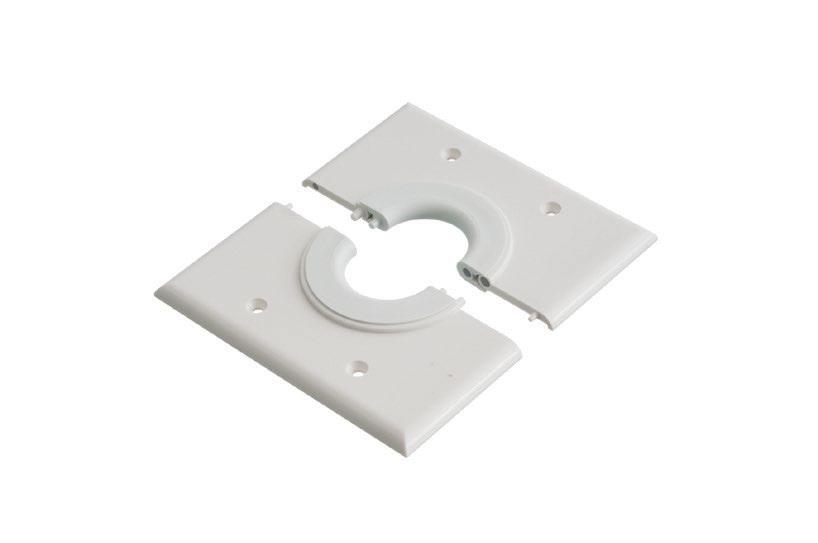


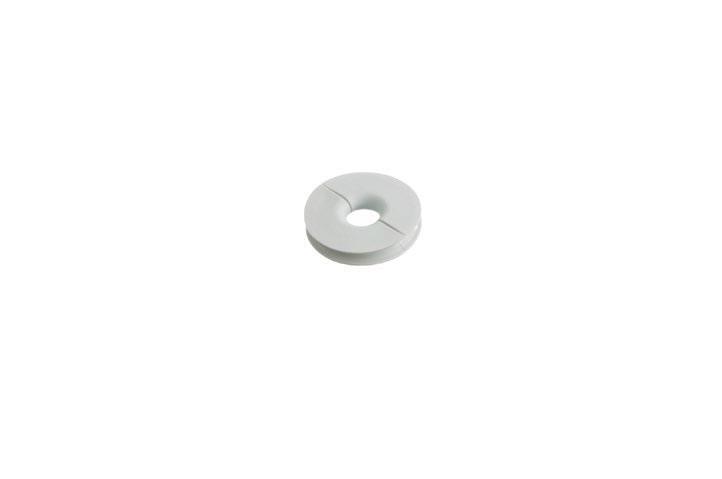


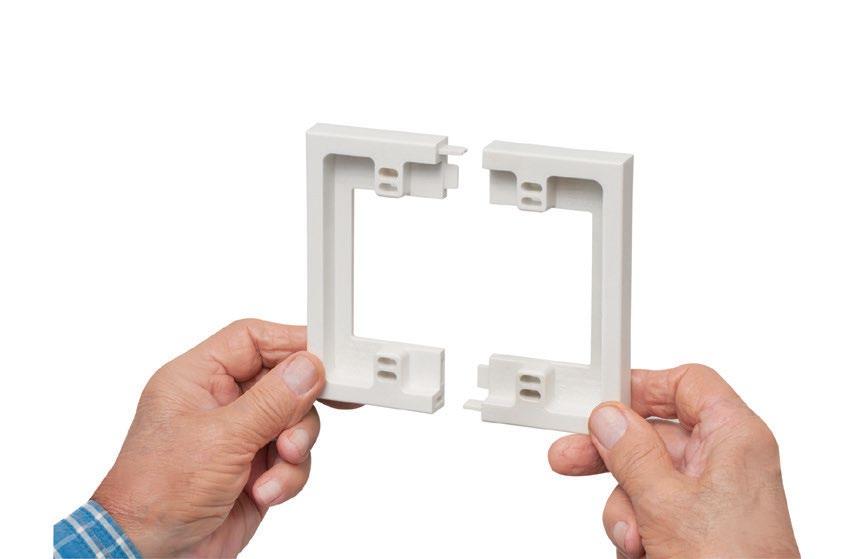


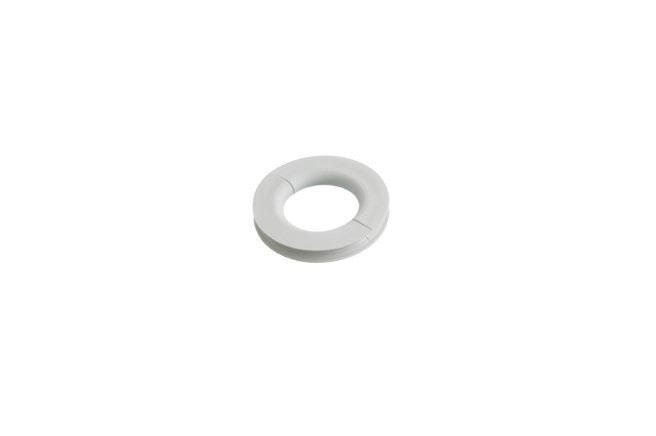
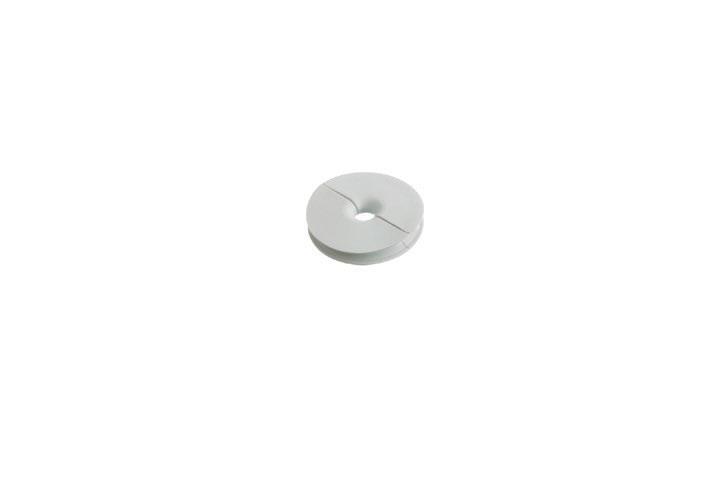
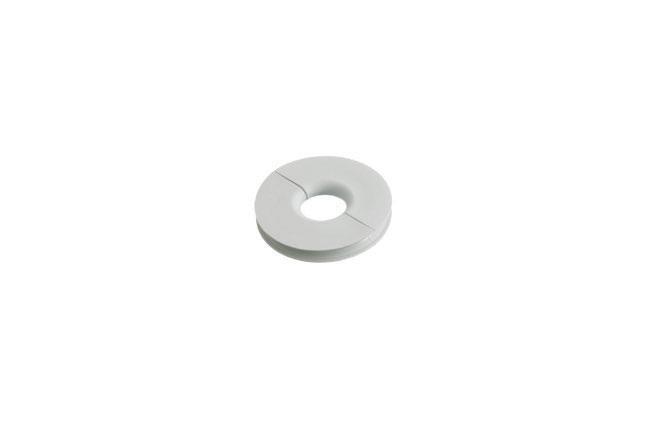




By Mark J. Pescatore
At its core, the new Shure MV7i “smart” microphone is a podcaster’s dream. It’s based on the same form factor as the SM7B, an XLR mic that’s based on the SM7 that debuted in the 1970s. Though it only weighs 1.25 pounds, this is not a small mic; it’s more than 6 inches long and 3.5 inches wide.
The back panel of the mic has a USB-C port for simple connection to your laptop or phone. There’s also a 3.5mm headphone jack, so you can monitor your audio directly from the source. But the star of the show—and the reason I simply had to test this mic—is a combo XLR/1/4-inch input. It allows you to connect another mic or a musical instrument, such as an electric guitar, and record both sources at once without a mixer.
DSP and Other Details
What’s in the box? The MV7i includes a yoke that allows you to angle your mic after it’s attached to a stand. There’s also a black windscreen that needs to be removed if you flip your microphone orientation for use with a boom mic stand, as well as a 10-foot USB-C cable.
A few technical specs to share: The MV7i features a cardioid pickup pattern, with a 50-16,000 Hz frequency response and adjustable gain up to +36 dB. It offers up to 24-bit, 48 kHz sampling, as well as 16-bit, 44.1 kHz sampling for iOS users. There’s also phantom power for mics that you plug into the MV7i.
The diecast aluminum mic body sports an LED touchpanel that provides a little built-in branding opportunity, too. You can customize the colors on the touchpanel through Shure’s MOTIV Mix Desktop app or MOTIV apps on your mobile device, so if you insist on putting your mic in the shot (don’t get me started), the LED display can be tailored to match your company’s logo color. You can also adjust the LED brightness and turn off the “pulsing” mode (for live metering) if you find it distracting. The touchpanel also serves as a mute button.
Several Shure DSP features are configured via the various MOTIV apps. For example, the Auto Level Mode with SmartGate provides real-time mic gain recalibration for consistent output and prevents overlapping dialogues during two-channel recording. There’s also the adjustable reverb (good for music, not so much for interviews), Digital Popper Stopper, and a real-time denoiser, which does an amazing job removing ambient noise you didn’t realize was there until you shut it off.
I really like the audio output choices. Not planning on a lot of post? Mixdown is the down-and-dirty

option, combining both sources into one mono signal. Multi-track keeps both signals as separate mono tracks, so you can separate them later for editing. And the stereo setting records one stereo audio track, adding the mic input to both channels along with the stereo audio from the 1/4-inch jack. That’s a good choice for a music demo or maybe a voiceover with some background music.
There is a catch: The MV7i only supports mics or instruments with an XLR or 1/4-inch output; there’s no USB-C input. I suppose that could be on the product roadmap for the future, but for now, you’re limited to analog.
On its own, the MV7i is an outstanding USB microphone. Use it and you’ll be the best sounding participant in your next videoconference, or you can output the audio directly to your DAW. You need one of the MOTIV apps to change the out-of-box settings and set your output mode, but you don’t need it to actually use the mic.
The multi-source audio magic happens in the MV7i itself. To test it, I plugged in an Audio-Technica AT2040, a hypercardioid dynamic mic that’s also purpose-built for podcasting. I know it was to work, but I was still amazed that I had two highquality mics from two different manufacturers working in concert with only one USB cable feeding my laptop. It also worked flawlessly with my iPhone.
Both mics sounded great, but the Shure’s extensive digital effects do not automatically carry over to the second mic. At one point, the MV7i sounded like it was deep in a concert hall, while the AT2040 sounded like it was, well, in my office. To fix this, go into a MOTIV app and adjust the XLR or

1/4-inch input separately. I decided to match both mics, but you can choose what sounds best for your project.
Once you configure both inputs the way you want them, the MV7i keeps those settings, even if you unplug the mic. So, when I connected the MV7i to a second computer and specified it as an audio track in my Mixcraft DAW, that concert hall sound came through on both mics.
For my next test, I dug out my old Audio-Technica PRO 3H, a handheld mic I think I’ve owned since parachute pants were a thing. The XLR mic plugged in without a problem. It still sounds just fine, by the way, but the on/off switch was useless—it was always on when plugged into the MV7i. Still, the MV7i played nice with my XLR mics, old and new.
Then, just to be thorough, I pulled out my electric guitar. Don’t get excited— I know maybe five chords, but at least I could test the mic. It was easy enough to insert my cable into the 1/4-inch jack, which is hidden inside the XLR port.
I slipped on my beyerdynamic DT 770 headphones and plugged them into the MV7i’s headphone jack, turned on the app, strummed a G, and there it was. No mixer, no external converters, no amp, just a boy and his guitar. Add a little reverb on the vocal and suddenly I’m getting delusions of bright lights and merchandising deals.
The MV7i is priced at $349, and Shure also offers a podcaster bundle that includes the no-frills MV7X (with XLR output) for $499. So, do I recommend it? Well, if you just need a USB podcast microphone, Shure’s MV7+ offers the same look and performance as the MV7i for about 20% less. However, for podcasters on the go, or even corporate podcasters with limited space or technical know-how, it’s hard to think of a simpler wired setup with this level of quality.
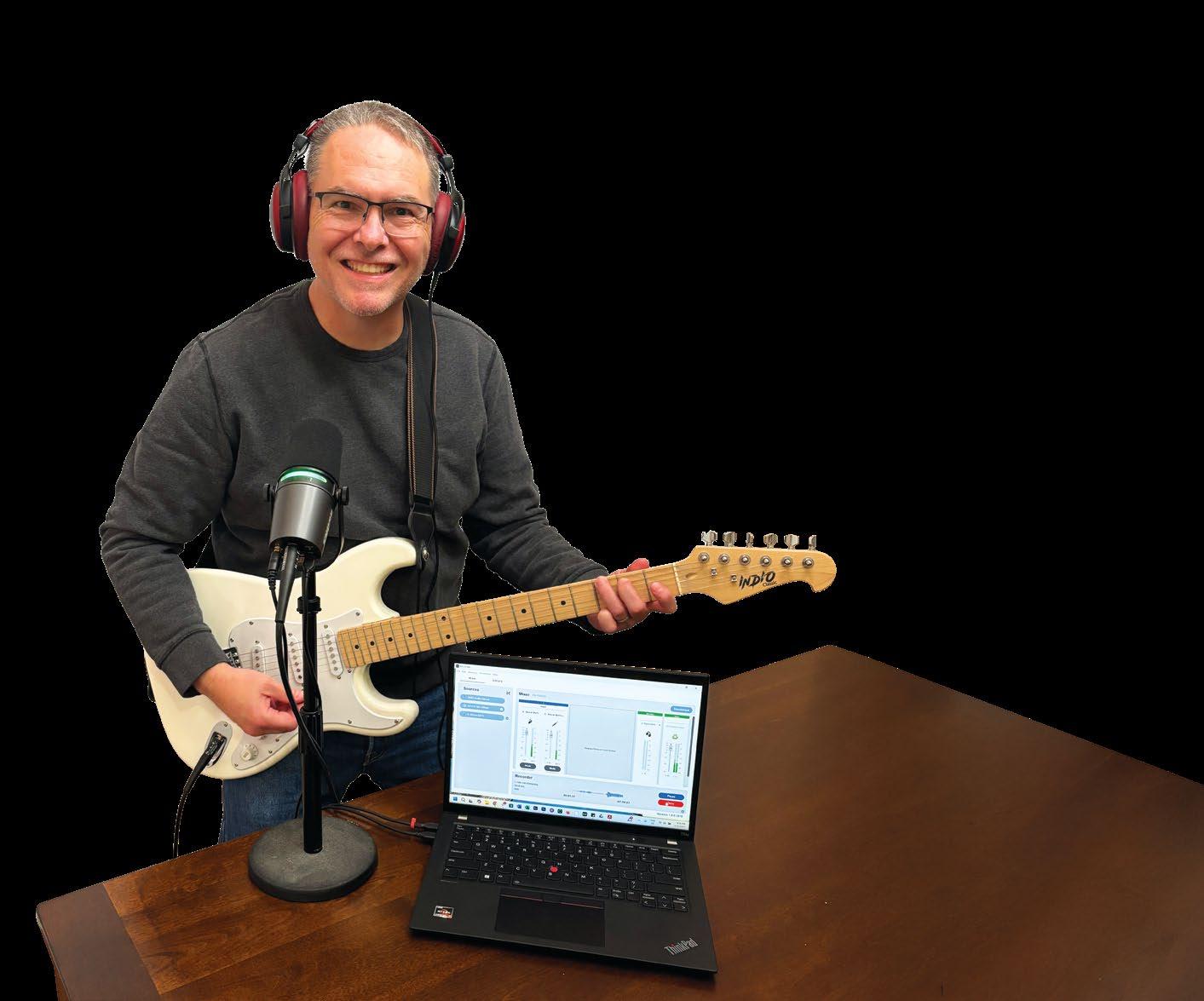
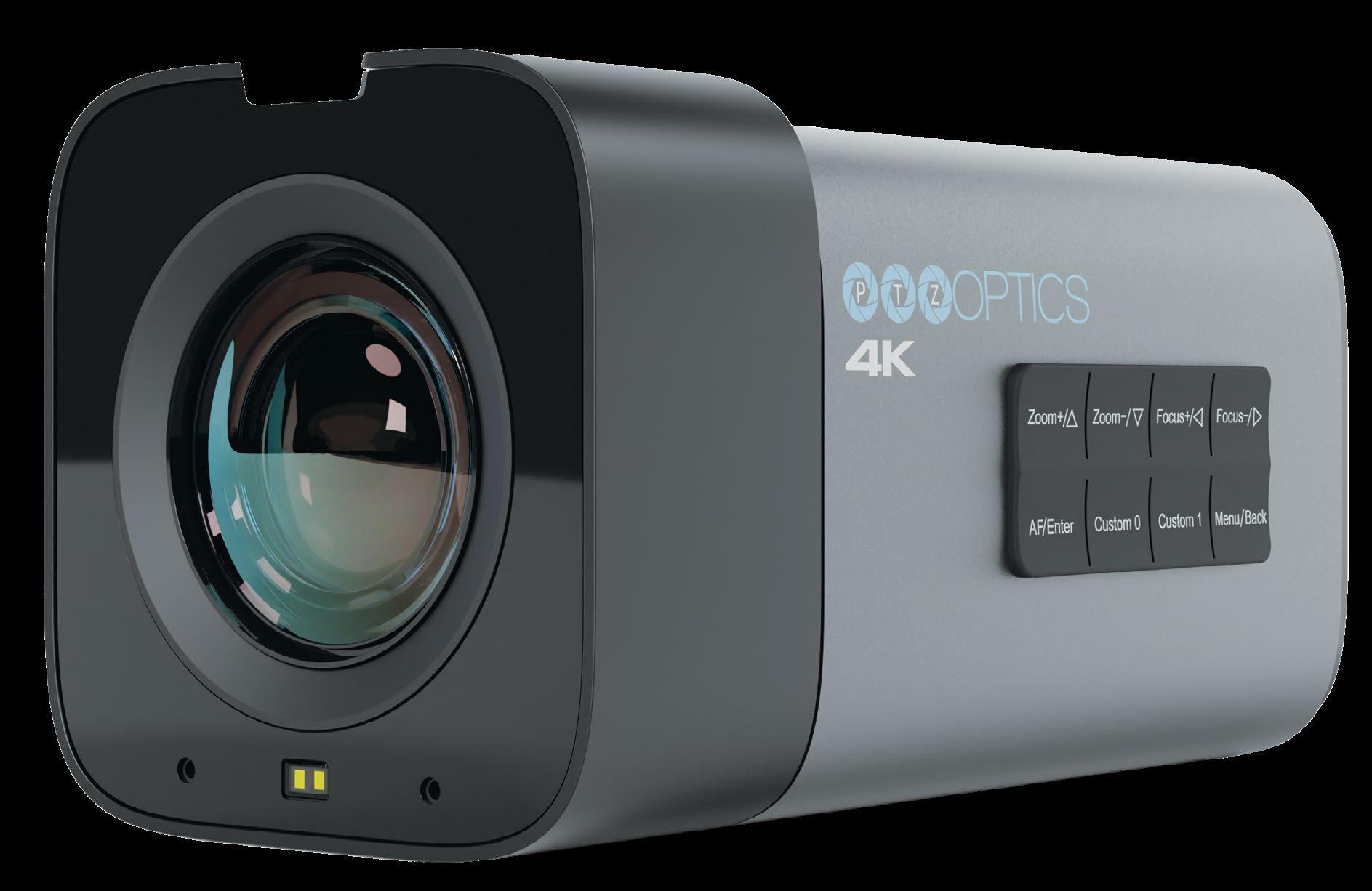
New PTZOptics Studio 4K Indoor Camera Is a Compact Workhorse
By Chuck Gloman
When you think versatility, you usually don’t think about a box camera. But the new PTZOptics Studio 4K camera is changing the fixed camera conversation.
The Studio 4K’s 1/2.8-inch, 8MP CMOS sensor delivers 4K, Full HD, 1080i, and 720p via HDMI, as well as 1080p, 1080i, and 720p via SDI. It can livestream H.264/H.265 video on a network or record the footage to an external source. Supported protocols include NDI HX2, SRT, RTSP, HTTP, TCP/IP, and more.
Operating independently or with other cameras on PTZOptic’s Hive Studio online platform, the camera provides a 72.5-degree angle of view and features a 12x optical zoom. (A 20x model is also available.) Other features include a built-in tally light, so it's ready for multi-camera setups, and a built-in beamforming microphone. And the camera itself is less than 6 inches long and weighs about 1.5 pounds.
Facing the camera, both the left side and bottom sport wall mounting screws. The rear panel has a green LCD standby and red LED power light. There’s also a 12-volt DC input, 3.5mm I/O, USB service port, RS485 control port, and SDI, HDMI, USB, and IP outputs. The right side of the unit has soft buttons for menu access, zoom and focus (which double as
directional buttons for menu navigation), auto focus, and two custom presets.
Small Package, Big Features
Press the menu button to display the on-screen menu options of exposure, color, image, PTZ, noise reduction, setup, information, restore default, and privacy mode. Exposure offers auto, manual, SAE, AAE, and bright options. A built-in meter allows you to choose the areas on the screen where exposure will be prioritized.
In the auto option, the exposure is automatically controlled and is extremely accurate. In the manual setting, you have access over the shutter speed, iris (which defaults at 1.8), and gain. In the SAE mode, you have options of shutter, gain limit, and DRC access to various areas to check the exposure.
The color menu offers control over the white balance, including various modes as well as saturation and hue. The image portion of the menu provides access to luminance, contrast, sharpness, gamma, flip (horizontal and vertical), and more. Under the PTZ menu, you can shut off the digital zoom or restrict its use, set the zoom speed, freeze the image, and toggle between displaying information on the screen or not. The camera also offers 2D and 3D noise reduction at various levels.
The Studio 4K ships with a remote control with batteries, lens cap, AC adapter, and a USB-A to USB-C cable. The remote control is critical for the camera’s operation, especially if you want to adjust many of the menus or sub menus. Once you have the parameters you want, it’s probably easier just to preset it. You can also access the same functions on the side of the camera—but depending on where it’s installed, the remote is a much more convenient option.
When I first plugged in the Studio 4K, I was literally stunned at the crisp image. It was superior to that from our $60,000 4K studio cameras (granted, they’ve been around for almost a decade). On startup, the color
balance and focus were perfect.
I immediately saw this camera as an overhead option in our 40x60-foot studio for an overhead wide shot for bumpers or credit rolls. Using the remote, you can zoom in or out to frame the exact shot you want. Of course, I would have liked some type of pan and/or tilt functionality, but this is a box camera, not a PTZ model.
In our studio, I mounted the camera in the upper right-hand corner of the room using the same mount that held our lesser-quality surveillance camera. The camera easily captured the entire room. So instead of relying just on three floor studio cameras, we now had a fourth camera that could show the studio audience as well as what was happening on our set. We used the 3G-SDI output from the back of the camera to connect it to our switcher.
The only things I didn’t test were the Ethernet connectivity and the camera’s integration with the PTZOptics Hive Studio online platform. We did use the HDMI port to connect the camera to one of our monitors. Using the remote, our floor manager would zoom in to a tighter shot of the studio audience, if needed. A joystick option would make this process more streamlined—and as it turns out, PTZOptics offers a few joystick controllers that’ll do the trick.
The PTZOptics Studio 4K is a great camera choice to capture your static indoor wide shot in pristine 4K quality (though you can zoom, too). PTZOptics also offers the less expensive Studio Pro, which only offers Full HD resolution, but it might be all you need for your setup. Basically, either model is a set-it-and-forget-it option for studios, churches, city hall, and more. There’s virtually no setup, plus it’s compact and lightweight, delivers stellar images, and gives you total control of the recorded image.
Chuck Gloman is an associate professor of the TV/ Film Department at DeSales University. Contact him at chuck.gloman@desales.edu.

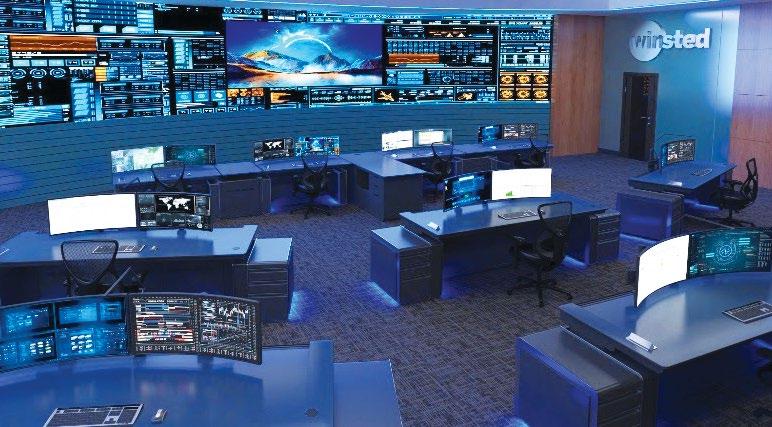
Building on the success of the Pinnacle console with power-actuated adjustable height options, Winsted has expanded its Pinnacle Technology Furniture collection. Featuring a sliding worksurface, the Pinnacle console enables uninterrupted cable management and serviceability without disrupting operator workflow in mission-critical environments. The expanded collection—including technology cabinets, drawers, credenzas, peninsulas, and conference tables—is engineered for flexibility, security, and seamless technology integration to optimize workspace efficiency and productivity. The technology cabinets offer flexible mounting options and enhanced equipment storage, the drawers and credenzas offer secure storage and removable back panels, and the conference tables offer built-in cable management and connectivity solutions. Pinnacle’s three-tier cable management system ensures a clutter-free workspace, with dedicated routing pathways and full-width mesh trays for efficient and organized cabling. The collection is available in a range of sizes and configurations, including custom solutions.

Telycam’s first professional box camera, the Vision+ 4KZ, provides a cost-effective solution for live production and Pro AV applications that require 4K video quality but don’t need PTZ control. The Vision+ 4KZ captures 4K60 video via its 1/1.8-inch, 9MP CMOS sensor and offers 20x optical zoom. It can also simultaneously crop an additional 1080p output from the 4K image, with auto-framing keeping important subjects automatically in view. A unique integrated side control panel with color screen displays key camera parameters and image attributes, while the control panel’s five buttons allow users to adjust settings directly on the camera. The box camera can also be remotely managed via an intuitive, browserbased web interface and standard control protocols. HDMI and USB output interfaces are complemented by support for NDI HX3, SRT, RTSP, RTMP, and more.
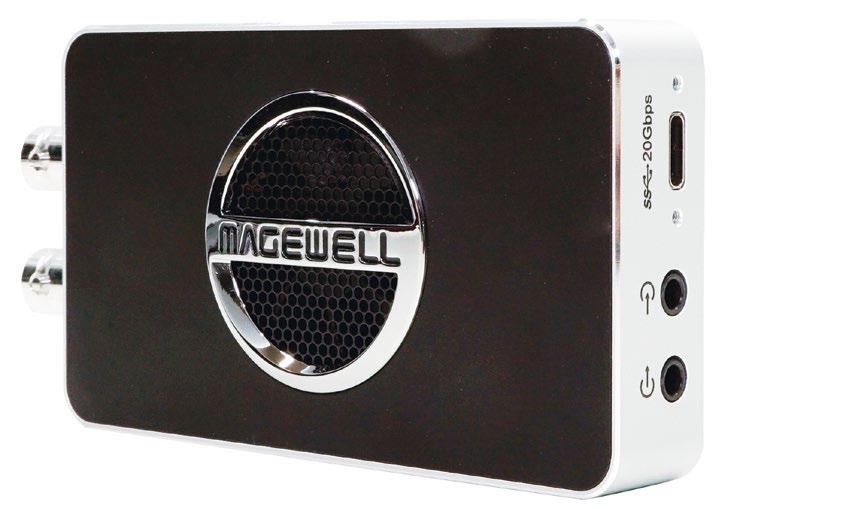
The new USB Capture SDI 4K Pro is a small, plug-andplay device that enables PCs to capture SDI signals up to 4K resolution at 60fps via standard USB 3.2. It’s the newest in a line of USB Capture products. Able to capture SDI signals up to 4,096x2,160 (including 3,840x2,160) at 60fps with 4:2:2 chroma fidelity via the USB 3.2 Gen 2x2 interface, the USB Capture SDI 4K Pro provides seamless video capture with minimal CPU usage and no external power source. The unit can accept many different video formats up to 12G or frame rates up to 240fps. Along with video, the device can capture two channels of embedded audio or analog audio via a 3.5mm line in interface. Embedded audio can also be extracted and output via the 3.5mm line out interface.
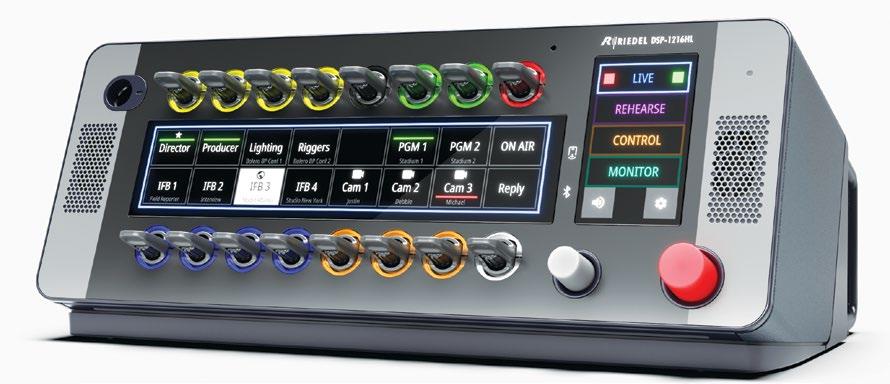
A compact, ergonomic desktop intercom panel, the DSP-1216HL offers a space-saving, multifunctional interface for professionals in live event production, sports venues, theaters, broadcast, and more. At launch, the DSP-1216HL supports all three 1200 Series SmartPanel Apps. It features 16 hybrid lever keys for intuitive talk-mute and talk-listen workflows, along with high-resolution, full-color multitouch displays and customizable LED rings for clear signalization. The DSP-1216HL includes extensive connectivity options and a clear focus on open IP standards. The panel’s 2.1 speaker system not only enhances intercom workflows with intelligibility in headset-free scenarios, but also enables users to confidently use it as an audio monitoring solution. The space-saving footprint and VESA mounting option make it even more versatile, allowing users to create a floating setup to maximize space and flexibility.
The new PT-OTDR-100 mini OTDR tester provides a OTDR testing solution that is simple to set up and use. Its integrated 5.5-inch OLED touchscreen makes it easy to view cable tests, and the unit can save and export OTDR tests as SOR or PDF files.
The PT-OTDR-100 performs OTDR tests, OPM, VFL, and laser source

functionality for fiber optic cable, and performs continuity testing and TDR for Category cable. Among other tests, it measures optical fiber and connector attenuation (and faults), and displays loss distribution among the fiber length. Multiple adapters for fiber optic cables are included, and an RJ45 remote allows for copper cable testing.

Designed for professional stage performances, speeches, and various live events, the MM-58 cardioid vocal microphone features the MU-581D capsule, offering an outstanding highfrequency response that enhances vocal brightness, ensuring every word and note is delivered with clarity and precision. The optimized frequency response and high dynamic range accurately capture rich vocal details, preserving the natural tonal quality of the speaker or singer. MIPRO’s patented composite anti-shock suspension system significantly improves shock absorption, effectively isolating handling noise and ensuring a clean and distortion-free sound output. Built for longevity, the MM-58 features a precisioncrafted metal body for durability, and its highrigidity, multi-layer metal mesh structure effectively suppresses feedback. Plus, the integrated metal mesh pop filter significantly reduces breath and wind noise while being easy to detach and clean, maintaining optimal performance over extended use without aging-related degradation.

With StudioEdge, production teams can seamlessly introduce remote guests from every major videoconferencing platform—including Zoom, Microsoft Teams, and QuickLink’s built-in StudioCall technology—into productions, optimized with AI technology. StudioEdge allows users to create realtime group conversations, panel discussions, and live interviews, as it can manage any combination of remote guests from around the world, with direct communication and chat support for guidance. The system offers a browser-based, remote-control interface via QuickLink’s cloud platform from any global location. StudioEdge supports four channels of broadcast-quality discrete audio and video from remote guests. It can be seamlessly integrated into the production suite via IP and hardware I/O, and it supports direct, off-air communication between operator and remote guest(s) for complete control over the production.

Using Extron’s Vector 4K scaling engine, the MGP 641 xi can scale and present up to four 5K sources on a single screen, including ultra-wide displays. In addition to four HDMI inputs that support data rates up to 18 Gbps, the HDCP 2.3-compliant processor includes an HDMI background input for presenting live, non-scaled content behind the source windows at resolutions up to 5K. The MGP 641 xi 5K SDI model supports 12G-SDI sources along with HDMI. An HDMI output accommodates a local display, while the DTP3 output can drive a remote display up to 330 feet (100 meters) away with identical content. Users can also annotate over live content with an optional LinkLicense. With a rack-mountable form factor and variety of presentation and transition effects, it’s an ideal signal processing solution for corporate boardrooms, public auditoriums, or mission-critical situation rooms.


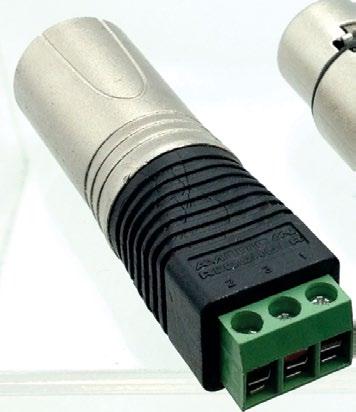
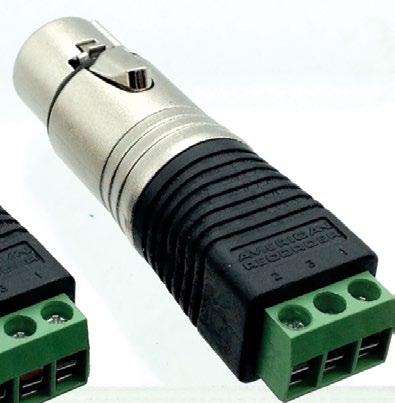
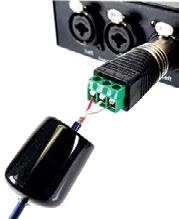
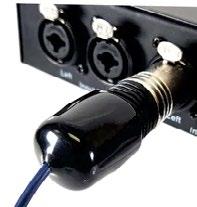
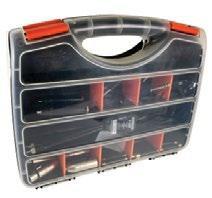












Profile Wireless is a 2-channel, 2.4 GHz all-in-one microphone system that can be used as a clip-on, handheld, or tabletop mic. The charging bar (pictured) stores and charges the key components of the system and doubles as a handheld or desktop mic. It securely holds a 2-channel mini-receiver with an OLED touch display, two pre-paired clip-on microphones that automatically connect to the receiver, magnetic clips for attaching the mics to delicate clothing, and adaptors for connecting the receiver to mobile phones or a camera cold shoe mount. Each clip-on microphone has 16 GB memory for 24-bit internal recording; additional recording modes protect against weak signals and clipping. All Profile Wireless components include mounting threads for table stands and other accessories. With its built-in gyro-sensor, the Profile Wireless receiver display automatically rotates by 180 degrees to remain legible.


Powered by ClassX, the FOR-A MixBoard is a fully software-based switcher that enables users to create complex compositions with unlimited layers via an intuitive GUI. The switcher supports various input types including SDI, NDI, and SRT, making it a versatile solution for hybrid production setups. The basic model supports eight inputs and two outputs, while the advanced model features 16 inputs and four independent outputs. Advanced DVE capabilities enable complex transitions and effects, while customizable shaders offer unique visual effects and color correction options. A built-in multiviewer allows operators to create custom layouts, while the SoundFlex audio mixing feature within MixBoard supports up to eight audio input tracks.

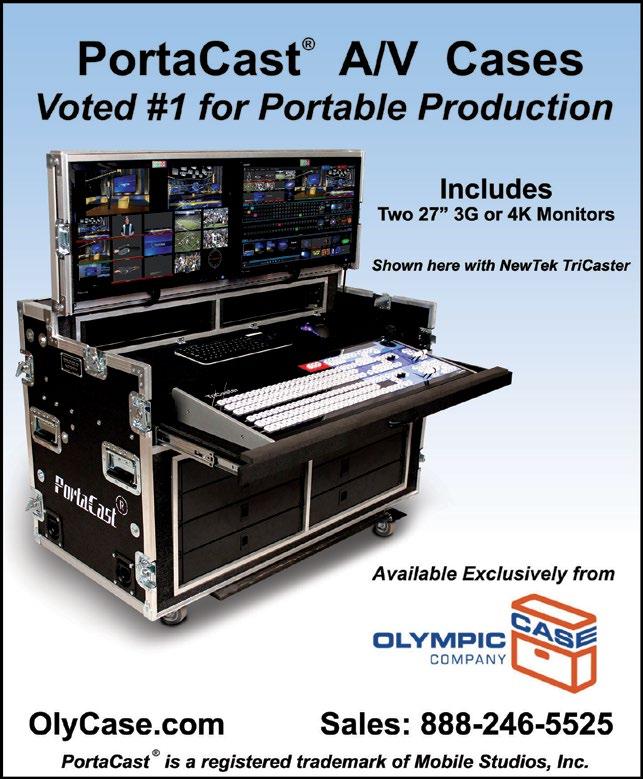


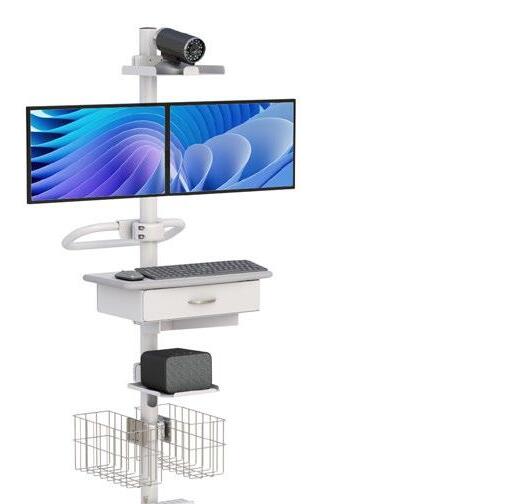


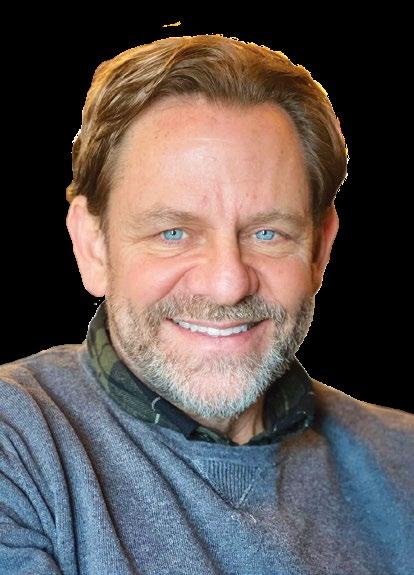
By David Isola
Today’s control room environments are increasingly complex—and integrators, contractors, and consultants are expected to offer design and deployment of solutions comprising a wide range of sources, data, devices, and tasks while ensuring both efficiency and reliability. To do so, AV over IP (AVoIP) partnered with IP-based KVM technologies is becoming a go-to combination for optimizing control rooms.
AVoIP and KVM technologies have historically been deployed as separate systems, each with its own infrastructure and management requirements. Today, control room systems that integrate KVM and AVoIP into a single solution not only boost efficiency but also simplify management.
To differentiate their offerings, integrators are now not only recommending, implementing, and integrating innovative solutions, but they are also accompanying customers with their expanding and future control room needs, offering support for their technology roadmaps/upgrades. This can include a full range of post-implementation services, from offering basic service contracts to full-service support or new technology upgrades. In doing so, service and solutions providers are becoming integral to their clients’ control room build and operations.
KVM over IP together with AVoIP technologies allow control room operators to deploy and smoothly switch between physical and virtual systems, monitor the systems across several desktop displays, and work more collaboratively by sharing ultra-high-resolution visuals on a video wall. Additionally, these technologies allow operators to streamline control room operations and reduce response times in critical situations.
Integrating video wall management features within KVM systems enables more flexible display control minus the complexity and costs. And, when they are equipped to monitor and manage multiple sources efficiently, operators can focus on critical tasks and collaborate more effectively with colleagues, boosting control room efficiency and responsiveness. We’re already seeing movement around replacing legacy hardware to reduce clutter. IP KVM can replace many devices and “clean up” the area around the operators. Loud and clunky
workstations are now being moved into a server room away from the operators’ desk and being replaced by a single desktop receiver that handles many (if not all) operator tasks. This also protects valuable computer hardware and software assets, keeps physical computers free of dust and debris, and guards them against hacker threats.
The command and control room solutions market will continue to be driven by the increasing demand for centralized monitoring systems across various industries. Advanced IP KVM solutions now have features that consolidate access to multiple systems, applications, and data sources into a single interface, whereas legacy systems rely on direct hardware connections requiring many additional devices.
With centralized monitoring, control room operators can now access the same systems in different locations for real-time collaboration and quickly hand off tasks without having to physically relocate. This also allows multiple operators to monitor different aspects from a centralized interface.
For example, many clinical lab customers are seeing significant improvements in the ability to monitor and collect data. KVM innovations have improved real-time data collection from analyzers and other pre-analytical instruments. The importance here is that KVM systems can centralize outpatient blood sampling and the integration of the various 24/7 laboratory units giving both patient research and scientific research easy facilitation using the same infrastructure—all with a workable, uniform, and standardized solution.
We will continue to see the combination of various


technology components in the control room, such as systems control and video wall processing, under a single KVM solution. This is particularly true in the control room solutions market that may have multiple distributed systems, multi-monitor setups, and video wall connectivity.
When developing a KVM solution for command and control, designers must build in real-time responsiveness to support high-resolution multi-displays. Fully scalable KVM systems are core to the future demands of a control room.
Plus, a reliable 24/7 environment requires redundancy and failover alternatives. The control room system needs to easily integrate with legacy hardware, offer user-friendly interfaces, and consider ergonomics to optimize operator efficiency and situational awareness. Most importantly, command and control centers must be carefully designed with ergonomics in mind to reduce human error incidents.
In essence, as control room operations evolve, organizations working with advanced IP-based KVM technology will have the ability to easily scale up connectivity, add systems and AV sources, and extend the scope of monitoring and control to address changing requirements and stay flexible. It is incumbent on Pro AV designers and integrators to consider critical elements including bandwidth requirements, monitor specifications, video resolutions, users and sources, cabling, and unique or specialized connection requirements.
The interesting aspect in KVM technology is how AI will fit into the picture. There is a lot of talk around the integration of AI with KVM, but at this point it seems to just be investigative in nature. However, there is a world of possibilities around AI through analytics, automation around decision making, and potentially remote monitoring capabilities.
From system log data to video screen data, mouse, and keyboard interactions, there are tons of data flowing through an IP KVM matrix system. It’s feasible that AI can aggregate real-time data from the multiple sources connected to the matrix.






















Potentially, AI could analyze network traffic data to identify latency in connected video streams, monitor data packet flows in networks, and further optimize routing efficiency in control room solutions. From there, AI could not only analyze the data, but detect anomalies, trigger alerts through automation, and even predict system failures based on switching delays, network usage, or hardware performance trends. AI is shaping the future in ways we are only beginning to understand, and this is especially true in KVM.
David Isola is the director of global product marketing for Black Box.

